Abstract
The catastrophic floods that hit Pakistan in summer 2022 represent the latest example of climate change-induced extreme events occurring in South Asia. In addition to the dramatic impact on population and infrastructures, this event threatened UNESCO World Heritage Sites (WHS) and properties of national interest. However, while a wealth of national and international mapping initiatives were conducted based on satellite imagery to assess damage to people, buildings and economic goods, the impact caused to archaeological sites and monuments has not been fully unveiled yet. To bridge this gap and provide an integrated approach that can be used by local end-users to assess damage and, in turn, collect evidence to inform and improve risk management plans, the present paper integrates Sentinel-1 and 2 imagery and mapping products derived from them (e.g., Copernicus Emergency Management Service Global Flood Mapping) with ground-truthing and geospatial datasets. Through a multidisciplinary collaboration between geologists, archaeologists, remote sensing and satellite image analysts, the integration methodology was tested on UNESCO and other heritage sites of national relevance located in the two mostly affected regions of Khyber Pakhtunkhwa and Sindh that were intentionally selected to represent different typologies of cultural heritage and governance in Pakistan. Finally, the information extracted from the present analysis was assessed in relation to the current national and international legislations, the official state of conservation reports and the activities conducted at each site to protect them against flood events. Given the accessibility to ready-to-use Copernicus products and that the present analysis can be replicated over time and other sites, the proposed methodology provides a feasible means to exploit satellite data in post-disaster mapping situations and contribute to the decision-making process for risk management.
1. Introduction
Floods are one of the most frequent natural disasters globally [1] with the potential to cause extensive economic and social damage. Although some uncertainties still persist, it is projected that disastrous floods would increase in many regions of the world—including Asian countries—as a consequence of climate and socio-economic changes [2].
Based on historical records, Pakistan has been long threatened by floods which caused major damage to infrastructure and killed thousands of people. The very catastrophic events that happened over the last two decades suggest an accelerating trend in flooding occurrence and severity, and the need to assess the associated hazard also in the context of climate change. In this respect, there is a substantial body of reports listing the statistics of affected population, fatalities, damaged and destroyed properties and infrastructure, livestock and croplands in Pakistan (e.g., [3,4]), as well as scientific literature investigating river flood hazard and their cause–effect relationship with weather, climatic and environmental factors (e.g., [5,6,7,8]). On the contrary, still few are the studies focusing on damages caused to cultural and natural heritage in Pakistan and predisposing factors at these properties [9]. This regional evidence in some way aligns with more global trends outlining that research on flood impacts on cultural and natural heritage is very limited compared with the growing concerns related to climate change [10].
Hazard and risk assessments need to be supported by objective observations and measurements. In this respect, remote sensing is nowadays largely acknowledged as a valuable resource, especially if combined with geological investigations, analysis of weather and environmental parameters, and ground-truthing methods. Among the available technologies and data, imagery collected from Earth Observation (EO) satellites provides a substantial contribution to address the different phases of the Disaster Risk Management (DRM) cycle starting from the emergency mapping [11]. Furthermore, there is an increasing exploitation of EO data for DRM of exposed cultural heritage [12]. Not to forget that the growing release of open access imagery and derived products, such as those of the European Commission Copernicus Programme, is stimulating the use in cultural heritage applications and exploitation by end-users [13].
Accounting for the above context and the last catastrophic floods that hit Pakistan in 2022, the present paper aims to assess the impact on a selected group of archaeological sites and monuments located along the Indus River by combining Copernicus data and on-the-ground evidence. Based on this specific event-related evidence, discussion is provided on the role that satellite technology and the proposed data integration methodology may play in strengthening resilience to future scenarios of climate change-induced flooding.
1.1. Floods in Pakistan in the Frame of Recent Climate Change and Global Policies
Since the early 21st century, flood frequency has dramatically increased at the global level, affecting over 2 billion people worldwide [14,15]. Numerous weather and hydro-meteorological events can cause floods, including heavy rains, monsoons, typhoons and even large landslides falling into rivers, reservoirs or dams. The most endangered regions in the world include medium-large swaths of plains from the Yellow and Yangtze Rivers valleys in China to the Tigris and Euphrates Rivers in Iraq and from the Ganges and Brahmaputra River valley in India and Bangladesh to the Indus hydrological catchments in Pakistan.
For example, the latest three major floods of the Indus River in 2010, 2011 and 2022 in Pakistan affected approximately 60 million people, reaching up to 3500 deaths [16,17,18]. Since the mid-20th century, Pakistan has experienced one major flood approximately every decade, mainly due to heavy monsoon rainfall. The multifaceted impact of these catastrophic events encompasses severe economic losses, dramatic humanitarian emergency, substantial damage to infrastructure, as well as the destruction of both the cultural and natural heritage of the country. The floods in 2010 caused an inundation of 71,000 km2 and hit around 900 thousand households [19,20]. In 2011, the floods inundated 21,000 km2 area, displaced 5.9 million people and damaged 1500 km of the road network, 382 km of railway tracks and 16,000 km2 of agricultural land [16].
The 2022 summer floods represent the latest example resulting in the record-breaking rainfall in July and August in Sindh province (more than +1000% of average precipitation rate), followed by floods in different districts of Balochistan. The floods started in July, intensified in August, and affected about 33 million people in the country. During those two months, unprecedented monsoon rainfall was recorded, with a high value of average precipitation in July 2022 (+180%) and the highest ever for the month in the last 62 years in Balochistan (+450%) and Sindh (+307%). Similarly, rainfall intensity in August broke the past 62 years’ historic record (+243%). Balochistan received a six-fold high (+590%) and Sindh seven-fold (+726%) above normal rainfall in both months.
These recent catastrophic events resulted in extensive damage to agriculture crops, livestock, and infrastructure [18,21]. However, studies focusing on damages caused to cultural heritage in Pakistan and factors predisposing to flooding hazard at specific sites are still few in the scientific literature.
To frame these recent events within the wider picture of global drivers, it must be noted that changes in temperature and precipitation are among the climatic factors identified by the United Nations Educational, Scientific and Cultural Organization (UNESCO) that pose threats to conservation of heritage sites [22]. In the context of climatic stressors and consequent risk that exacerbate exposure of cultural heritage, preservation of heritage sites of universal value and the determination of such risks threatening those unique values due to climate change are a significant challenge that heritage site managers are facing [23,24]. The vulnerability of cultural heritage sites has gained much attention worldwide as emphasized by the UNESCO policy document in 2008 [25]. However, from global to regional-local level, the current state of knowledge and implementation scenario may be very uneven. With specific regard to Pakistan, to the best of our knowledge, no systematic studies reporting the assessment of impacts of climatic change on cultural heritage sites have been conducted so far.
Therefore, the present paper aims to provide an initial contribution on a selection of UNESCO WHSs and non-WHSs to demonstrate how satellite data can be used to learn from occurred events, and extract geospatial information that may help end-users to manage risk from future flooding.
1.2. The 2022 Pakistan Floods and Rapid Mapping Efforts
The catastrophic flooding events started in July 2022 rapidly affected most of the Pakistani side of the Indus River valley. Their catastrophic effects triggered multiple national and international initiatives for mapping and monitoring the degree and extent of the damage throughout the country.
The resulting assessments have been conducted by applying different methodologies, ranging from satellite and aerial remote sensing to data collection in the field. The main target consisted of quantifying population exposure and migration, the extent of urban areas, large infrastructures, farmlands or roads that were affected.
The most comprehensive report including both satellite remote sensing and ground-truthing methodologies was released in October 2022 by the Government of Pakistan [21]. This report provides detailed information regarding the damage, loss and needs per sectors (social, infrastructure, productive and cross-cutting ones) following the dramatic floods that hit most of the country.
At international level, parallel efforts were conducted by the United Nations (UN) program UNOSAT, a division of the United Nations Institute for Training and Research (UNITAR), and the Copernicus Emergency Management Service (CEMS). Both the organizations exploited satellite images to document the pre-, during and post-flood situation over a large area of the country. In particular, one of the first products released by UNOSAT included a focus on Mohenjo Daro WHS [26]. Of the two CEMS activations, the one that could be of potential interest for cultural heritage assessment is rapid mapping activation EMSR629 covering the areas of Jacobabad, Larkana and Shikarpur in the Sindh region [27]. However, the extent of the mapped flooded areas does not include Mohenjo Daro WHS or other major heritage sites. On the other side, these multiple and simultaneous mapping efforts emphasize the relevance of satellite remote sensing for rapid assessment and continuous monitoring of the floods.
Another important assessment was produced by the International Centre for Integrated Mountain Development (ICIMOD) and Pakistan Agricultural Research Council (PARC). The team used Sentinel-1 and Sentinel-2 satellite imagery provided by ESA [18] to document crop losses in the Sindh region where rainfall was 726% higher than the monthly average. However, given the scope of the assessment, no specific focus was dedicated to the impact on cultural heritage.
Other relevant products include an insightful comparison between the 2010 and 2022 floods in Pakistan that was produced by UNOSAT using NASA Terra (MODIS) satellite. The remarkable increase of the submerged land in 2022, especially in Sindh (+16,000 km2) and Balochistan (+3900 km2), is also significant in the wider context of the more frequent climate change-induced events that are occurring worldwide.
In most cases, the above-mentioned satellite-based analyses have not been validated in the field and therefore, according to the producers’ recommendation, they must be considered as preliminary.
Field analyses have been coordinated by the Government of Pakistan (and integrated in the PDNA 2022 report [21]) with the support of the UN refugee agency UNHCR, and for children, UNICEF, and mostly focused on the human casualties and displacement as well as the loss of private houses, animal (i.e., cattle) and public infrastructures.
While the efforts by multiple actors both at national and international level using different (sometimes) integrated methodologies provided useful data and an effective monitoring of the human and animal losses along with the damage up to total destruction of buildings, farmland and roads, limited interest was garnered by the impact of the floods to the rich Pakistani cultural and natural heritage.
In this respect, one of the few exceptions is the PDNA report [21] and its supplemental report wherein chapters are dedicated to the damage, loss and need for recovery that involved the country’s heritage. Early estimates indicate that at least 149 sites have suffered partial but considerable damage across Balochistan, Sindh, Punjab, Khyber Pakhtunkhwa, and Special Regions. This number also includes the two UNESCO WHSs of Makli Necropolis and the Archaeological Ruins of Mohenjo Daro, numerous Buddhist stupas, Hindu temples, Islamic tombs and archaeological sites, as well as intangible practices connected to some of these places. In total, the report provides estimates of damage and losses to the national heritage equal to USD 6.1 and 6.7 million, respectively. Being a summary report with the main aim to understand the scale of resources required for recovery and reconstruction by calculating the damage, loss, and needs, the PDNA report is limited in the provision of detailed information about individual sites. Furthermore, the methodology used to achieve these estimates is not fully described. The accuracy relies on the available data that, in this circumstance, were accessed from the Public Sector and not also for historic properties controlled by the Private Sector. As such, this assessment conducted at national scale across a broad range of sectors cannot replace an ad hoc more systematic analysis of the impacts of the 2022 summer floods on cultural heritage of Pakistan. Under this perspective, it is interesting to note that, among the prioritized interventions in the culture and heritage sector, the PDNA report highlights the following:
- Detailed damage assessment for flood-affected heritage sites, as a short-term activity (up to 12 months), with priority 1 (i.e., the highest);
- Data collection on the impact on cultural professionals and specific recovery needs for each region and cultural practice, as a short-to-intermediate-term activity (from up to 12 months to up to 3 years), with priority 2;
- Capacity building of heritage management staff, as an intermediate-to-long-term activity (from up to 3 years to up to 5 years), with priority 2.
As a last note, first studies focusing on the impact of the 2022 floods on Pakistani cultural heritage are appearing in the scientific literature, such as Hegyi and Agapiou (2023) [9]. In their communication study, the authors tested the potential of different types of multispectral and radar satellite imagery including Sentinel-1 and Sentinel-2 as well as commercial data, on the UNESCO WHS of Mohenjo Daro to identify and monitor the flood extent and the resulting damage at the site. The study is a further demonstration that Copernicus data are a valuable dataset for impact and damage assessment, without the need to rely on complex or technically inaccessible methods for processing and analyzing these data. This is one of the foundational concepts of the present paper that aims, on one side, to demonstrate the usefulness of Sentinel-1/2 data per se as well as of the Copernicus products derived from them and, on the other, provide a wider assessment on a selection of sites beyond the most renown Archaeological Ruins of Mohenjo Daro WHS.
2. Materials and Methods
2.1. Rationale
With regard to the above prioritized interventions foreseen in the PDNA (2022) [21], the proposed methodology aims to demonstrate how Copernicus and open access data and derived products, combined with ground-truthing methodologies, can be effectively used by local professionals to undertake a detailed damage assessment for flood-affected heritage sites, and lead to considerations that may provide insights in order to identify specific recovery needs.
Towards capacity building of heritage management staff that, in future, may implement the proposed methodology, the feasible workflow for documenting the impact of floods was intentionally built upon the following pillars:
- Multidisciplinary collaboration;
- End-user-driven approach;
- Exploitation of open-access satellite data and derived products made available in format that facilitate their utilization by end-users.
The first two pillars are further detailed in the following Section 2.2.1 and Section 2.2.2, while the third one aligns with the method published in Zaina and Tapete (2022) [28] and is directly addressed in the Section 2.4 illustrating the data and products that were specifically used in the case studies.
The latter were selected to encompass the two WHSs of Mohenjo Daro and Makli Necropolis, which are known to have been affected by the 2022 floods (see Section 1.2), and the two historical monuments of national relevance of the Shah Jahan Mosque of Thatta and Kafir Kot fortress. All these sites are located along or close to the Indus River in Pakistan.
2.2. Methodology
2.2.1. Multidisciplinary Collaboration
The proposed methodology assumes that geologists, archaeologists and remote sensing and satellite image analysts from universities, research centers and intergovernmental institutions would work together. Such a collaboration represents a key element of this research because it serves for integrating different perspectives, and for seeking possible solutions to bridge the technical skill gap and the underestimation still frequently made by geologists and archaeologists on the potential of satellite images for the protection of cultural heritage.
The necessity for such an integrated collaboration has been recently stressed by various studies [28,29,30], proving the benefit from an increasing interaction among the different disciplines to achieve an effective “transfer of knowledge” and, in turn, lead to capacity building. This does not imply a full exchange of skills among experts from different fields, but rather a mutual improvement of theoretical knowledge and practical expertise.
Our approach, defined as “co-working”, is based on a specific operational chain by which tasks like data collection and analysis are designed and assigned according to the individual researcher’s skills, although all the professionals are engaged in the process. The last steps of the research, including the discussion of the results and interpretation, are conducted jointly. Furthermore, the critical assessment of the outcomes (especially from the geologist’s and archaeologist’s points of view) may suggest the need to go back to the data processing and analysis, if not even to data collection, and iteratively refine data selection, parameter setting for processing, etc., to better suit the final purpose [28].
Thanks to this collaboration, geologists and archaeologists are able to learn the variables that may impact on the quality and visibility of satellite acquisitions, as well as the characteristics of the satellites to use. Vice versa, remote sensing and image analysts are trained in tailoring satellite data acquisition and their processing to address specific user requirements. Such an improved awareness of the potential of satellite imagery will eventually allow geologists and archaeologists to master the data collection processes, tuning images into selection for their research scopes, instead of using available datasets that may have been randomly found on the web or through open sources.
2.2.2. End-Users
The methodology is designed to make the satellite-based assessment of flood impacts feasible and affordable to multiple end-users with different skills and knowledge. The use-cases are developed as if the flood impact assessment was made by personnel working at the UNESCO and non-UNESCO sites in Pakistan who are in charge of their preservation, without the need to download, store, process satellite data and generate products. The latter are indeed the typical steps of an operational chain performed by skilled researchers, departments, and geospatial information service providers. Therefore, the chosen approach reflects the likely real operational scenario when heritage professionals are asked to assess damage and risk due to floods and have to respond in a very timely manner. Even if personnel skilled in satellite data processing were included in the heritage site management team or the emergency task force (albeit a very unlikely condition in most cases, not only in Pakistan but in many countries in the world), the main priority for end-users is to achieve the needed information rather than investing time and efforts in data processing. Similarly, it can be said when the emergency is over, the post-event recovery starts and, ideally, risk mitigation measures should be planned. The scope therefore is that the methodology can be implemented by end-users themselves who may also have the interest to export it to other flood-prone regions and sites.
The four case studies considered in this research relate to a considerable number of stakeholders including national and provincial organizations, individual practitioners, and companies as well as academic organizations (Table 1). The methodology was therefore designed with this spectrum of end-users in mind. All of them have a broad understanding of the potential of remote sensing for documenting and protecting endangered heritage and the need for low-cost user-friendly tools for conducting their work duties [31]. Given the geographic focus of this research, the list reflects the hierarchy in cultural heritage management from national to local levels in Pakistan. However, the concept can be adapted to other geographic locations worldwide, according to the specific governance schemes.

Table 1.
List of reference end-users in Pakistan with regard to whom the methodology was developed.
2.3. Case Studies
The four case studies investigated in this research (Figure 1) were selected based on two main variables: geographic and institutional.
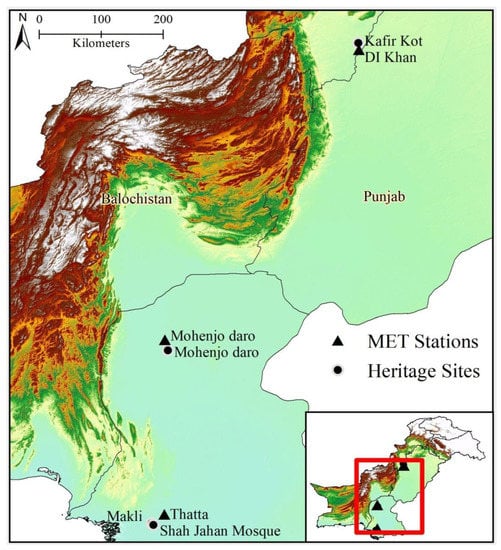
Figure 1.
The study map of Pakistan showing the geographical distribution of the selected heritage sites and the location of meteorological stations.
The geographic variable regards the selection of archaeological sites and monuments in those regions that were mostly affected by the 2022 summer floods and, as such, are representative of flood-prone sites. According to PDNA (2022) and the ICIMOD report [18,21] (see Section 1.2), Sindh and Khyber Pakhtunkhwa were the most affected regions. In particular, the rainfall records measured near three of the selected sites (see locations of the meteorological stations in Figure 1 and the rainfall data in Figure 2) was exceptionally high by 20-fold and 16-fold in July and August 2022. In DI Khan meteorological station, the rainfall was double the normal, but the situation was worse due to flash floods from the adjacent hill torrents in the west. The comparison of rainfall data between normal seasons and the 2022 floods is shown in Figure 2.
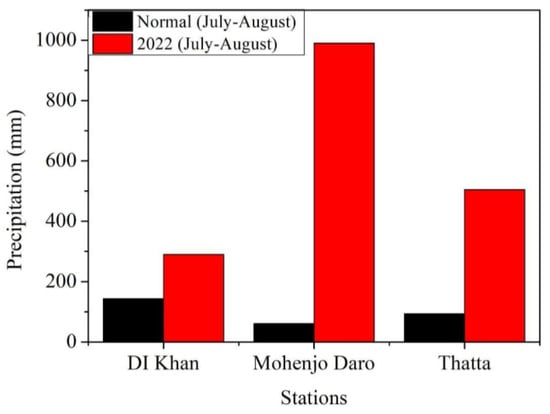
Figure 2.
Comparison of rainfall data measured in July and August 2022 vs. the normal values that are typically recorded in the same months at the three closest stations to the heritage sites investigated in this study.
The institutional variable regards the legislative status of the archaeological sites and monuments that were selected. We distinguished between UNESCO WHS and non-WHS sites protected by the Pakistani national law. This selection allows the analysis of the flood impacts to be extended across sites under different levels of protection.
In the following sections, a historical and archaeological background is provided for each site, together with an analysis of the pre-flooding monitoring activities and the threats identified by site managers to understand the state of preparedness prior to the occurrence of the 2022 summer floods.
2.3.1. Mohenjo Daro
The archaeological site of Mohenjo Daro is the best-preserved urban settlement in today’s Sindh province of Pakistan (Figure 3A–C). Located on the right bank of the Indus River, 510 km north-east from Karachi, the site prospered between the beginning of the 3rd millennium BCE and the first half of the 2nd millennium BCE, representing a major centre of the Indus valley or Harappan civilization [32,33].
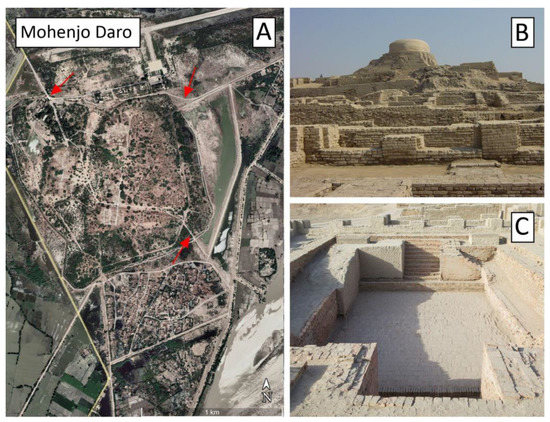
Figure 3.
The UNESCO World Heritage site of Mohenjo Daro: (A) satellite image showing the extent of the site. The red arrows indicate the main road (upper left) and the secondary accesses to the site (upper and lower right) (Google Earth, 31 March 2022); (B,C) overview and details of the monuments (retrieved from [34], copyright © CRA-terre).
After its abandonment, the city was then newly re-occupied at different times for more than two millennia [33]. The discovery of Mohenjo Daro in 1922 [35,36] revealed a 300-hectare-large city with a complex urban layout characterized by mud-brick domestic, religious and secular buildings including the so-called “Great Bath” or “Great Hall”. According to McIntosh [33], the complex interaction between the local people and the Indus River was already apparent at ancient Mohenjo Daro, as confirmed by the presence of large flood defense platforms managed by a specific authority. In addition to this multiple drainage system, wells and soak pits for disposal of sewage are a tangible proof of a well-organized civic, economic, social and cultural system, especially against natural disasters.
The current ruins of Mohenjo Daro are divided into two sectors: a citadel area to the west, characterized by a Buddhist stupa built above previous ruins during the 2nd century CE, and the lower town to the east consisting of highly organized neighborhoods belonging to the 3rd and 2nd millennium BCE city extending until the Indus riverbank.
The main entrance to the site is from the north-west (Figure 3A), although secondary roads give access to some archaeological areas also from north-east and south-east. In the case of floods, the accessibility to the site is a crucial component for allowing first aid and constant monitoring by local personnel and the potential end-users of our methodology (see Table 1). Therefore, in our analysis of the impact of the 2022 floods at the site, we have also considered the effect on the road system.
Mohenjo Daro was declared as a WHS (No. 138) in 1980 [37]. Since then, different monitoring and conservation activities have been conducted. Six official UNESCO State of Conservation (SOC) reports have been issued from 1991 to 2011. The main information provided by each SOC is summarized in Table 2.

Table 2.
List of damaging factors [38], actions required and implemented from the six SOCs issued over time for the Archaeological Ruins at Mohenjo Daro WHS.
Between 1974 and 1997, a joint International Campaign for the Safeguarding of Mohenjo Daro, launched by UNESCO and the Government of Pakistan, brought substantial improvement in the protection of the site. The main issues encountered over time include: lack or ineffective management system, rain and water table damage to the mud-brick walls, tourism and flooding. While the first two threats remained a pressing issue throughout the years (and reports), after the turn of the current century, flooding was not officially included in the reporting as an issue. On the other hand, flooding was included in the conservation issues presented to the World Heritage Committee (WHC) in 2007, with indication that the objective of the scheme related to river training aimed to eliminating the threat of flooding was achieved. Then, as described in the Report on the WHC Post-flood Assessment Mission to Pakistan, 7–15 October 2010 at Mohenjo Daro, the 2010 heavy floods had an impact on the site. As part of the conservation issues presented to the WHC in 2011, it was reported that around 1100,000–900,000 cubic feet per second water flow past the World Heritage property which was protected by bunds and spurs constructed during the UNESCO International Safeguarding Campaign (1974–1997). At that time, the river training scheme consisted of the construction of the outer bunds and stone pitched t-spurs for the purpose of preventing the river, with its ever-shifting course and seasonal overflow, from eroding the site. The inspection after the flood event found that urgent consideration must have been given to the possible strengthening of the vulnerable mud embankment and spur located to the north of the property. Furthermore, the technicians found that the emergency response plan of the property functioned well. Nonetheless, updating of the risk management plan was recommended.
2.3.2. Makli Necropolis
Makli is among the largest necropolises in the world (Figure 4A–C). Located in the southern province of Sindh, it includes an enormous cemetery with half a million tombs and graves in an area of about 10 km2 [45]. This cemetery served the historical Mughal capital of Thatta (located 6 km away from it) which flourished between the 14th and 18th centuries CE. Among others, the necropolis features several large funerary monuments (Figure 4B,C) belonging to kings, Sufi saints and scholars [46].
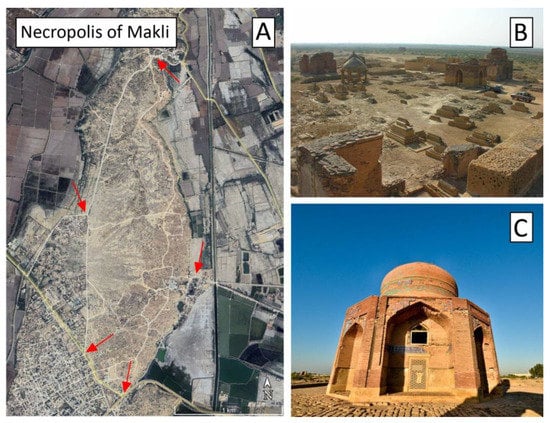
Figure 4.
The UNESCO World Heritage Site of Makli Necropolis: (A) Satellite image showing the extent of the site. The red arrows indicate the roads leading to the site (Google Earth, 14 September 2022); (B,C) Overview and details of the monuments (retrieved from [47]).
The main entrance to the site is from the north-east (Figure 4A), although multiple secondary accesses lead to the burials and the monuments from south and west. As for Mohenjo Daro WHS, in case of flooding and heavy rainfall, site accessibility represents a critical element that allows for first aid and constant monitoring by local personnel and the potential end-users of our methodology (see Table 1). Therefore, in our analysis of the impact of the 2022 floods at the site, we have also considered the effect on the road system.
Makli Necropolis was designated as a UNESCO World Heritage Site in 1981. Since then, the structural integrity of the site has been affected by multiple factors, chiefly siltation, encroachment, poor site management, vandalism, and solid waste. The 2010 Pakistan floods brought out another major threat contributing to the site deterioration. While no monitoring activity has been reported during the 1980s and 1990s, sixteen SOC reports have been issued from 2006 onwards including five reports produced by the Pakistan government. The main information provided by each SOC is summarized in Table 3.

Table 3.
List of damaging factors [38], actions required and implemented from the sixteen SOCs issued over time for Makli Necropolis WHS. SOCs 2009–2010–2011, 2012–2013–2015 and 2017–2019–2021 have been merged in three groups as no relevant changes emerged from one to the other.
According to UNESCO SOCs (Table 3), floods have never represented a severe issue for Makli Necropolis. This is plausible owing to the distance between the site and the Indus River area, alongside the topographic location. Nevertheless, previous extreme climatic events like the rainfall leading to the 2010 floods had an impact on the site. It is noteworthy how these natural phenomena brought to the recommendation in 2011 SOC [51] of setting up a weather station for monitoring climate fluctuation which has been installed afterwards, between 2016 and 2017.
Other important reports stressing the necessity of further protection for Makli Necropolis were produced in 2012, 2016 and 2019 as a result of the Joint ICOMOS/UNESCO reactive monitoring missions at the site [59]. For the scope of the present research, in these reports, flood was still considered a major damaging factor for the site and the authors called for the need to implement disaster preparedness measures as soon as possible. This has been only partially fulfilled with the development of a provisionary management plan between 2016 and 2017. The previous and current situation make the historical site of Makli Necropolis an ideal candidate for testing our integrated methodology.
2.3.3. Shah Jahan Mosque of Thatta
The Shah Jahan Mosque built in the mid-17th century CE is the main religious center in the city of Thatta, in the Sindh province (Figure 5A). The brickwork structure is considered one of the most elaborate stylistic examples in Asia [60]. Its fourinwan layout is characterized by 93 domes and two main chambers enriched with blue tiles decoration representing a mixture of Turkic and Persian styles (Figure 5B,C) [61].
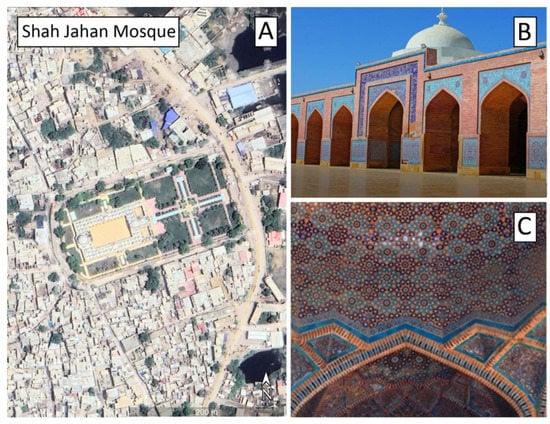
Figure 5.
The Shah Jahan mosque in Thatta: (A) satellite image showing the mosque (Google Earth, 14 September 2022); (B,C) overview and details of the monuments (photo by the authors).
Due to its historical and architectural relevance, the mosque was included in 1993 in the UNESCO World Heritage sites Tentative list. Unlike the WHS, the building is not subject to periodic reporting and its conservation by UNESCO. However, Thatta is protected as a national heritage site. As such, according to the Archaeological Exploration and Excavation Rules (1978) and the Antiquities Act (1975), its conservation and monitoring fall under the responsibility of the Directorate General of Antiquities and Archaeology and the Government of Sindh. The latest restoration and monitoring activities that were promoted date back to 2016, although no report describing the works undertaken is currently available. Given its different legal position and historical importance, the mosque represents an important national heritage for testing our methodology.
2.3.4. Kafir Kot
Kafir Kot is a walled site located in the Khyber Pakhtunkhwa province of Pakistan. It includes the ancient ruins of five Hindu temples and several forts dating to the 7th century CE [62,63].
The main entrance to the site is located on the northern side (Figure 6A), with the main access road running along the right bank of the Indus River. As for Mohenjo Daro and Makli Necropolis WHSs, the accessibility to the fortress represents a critical element for first aid and constant monitoring by the local personnel and the potential end-users of our methodology (see Table 1) in case of floods. Therefore, in our analysis of the impact on Kafir Kot due to the 2022 floods, we have also considered the effect on the road system. Furthermore, the site is located less than 6 km from an important hydraulic infrastructure, named Chashma barrage, which was built in the 1960s–1970s, is used for irrigation, flood control and power generation [64], and includes a large barrage and a reservoir to re-regulate the supplies of Tarbela reservoir [65] and collect waters in case of heavy rains and floods.
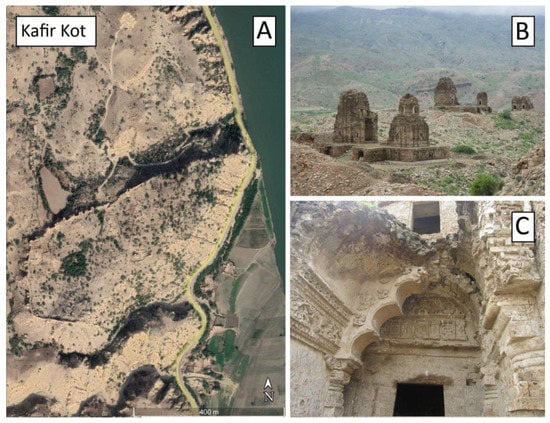
Figure 6.
The fortress of Kafir Kot: (A) satellite image showing the walled site and the main accesses and roads (Google Earth, 4 December 2022); (B,C) Overview and details of the monuments (from Wikimedia commons).
As for the Shah Jahan Mosque of Thatta Tentative WHS, the fortress is not a WHS and for this reason it is not subject to periodic reporting and its conservation by UNESCO. However, the site is protected as a national heritage site. As such, according to the Archaeological Exploration and Excavation Rules (1978) and the Antiquities Act (1975), its conservation and monitoring are under the responsibility of the Directorate of Archaeology and Museum and the Government of Khyber Pakhtunkhwa. While minor restorations have been conducted at the site, a proper management plan including strategies for conservation and risk management is currently missing. Given its different legal position and historical importance, the fortress represents an important piece of national heritage for testing our methodology.
2.4. Satellite Data and Derived Products
According to the rationale described in Section 2.1, the satellite imagery and derived products that were used include the Copernicus Programme Sentinel-1 Synthetic Aperture Radar (SAR) and Sentinel-2 multispectral time series and the products derived from them that were made available from either international rapid mapping efforts or Copernicus Services.
The full list of Sentinel-1 and Sentinel-2 is reported in Appendix A. In particular, the whole archive of cloud-free Sentinel-2 images collected from early July to 30 October 2022 was accessed in Level-2A Bottom-Of-Atmosphere (i.e., atmospherically corrected) raster geotiff format, and analyzed according to the method by Tapete and Cigna [66], with a particular focus on the visible bands (10 m spatial resolution). To complement the Sentinel-2 time series, especially in those dates and time intervals when cloud coverage hampered the visibility, Sentinel-1 SAR images, collected in Interferometric Wide Swath Mode at 20–22 m range by azimuth resolution, were accessed in Level-1 Ground Range Detected (GRD) raster geotiff format [67] and analyzed.
The spatial and temporal evolution of the floods was monitored by means of visual inspection of the original Sentinel-2 satellite imagery for a first assessment and, from a quantitative point of view, through the maps of flood water extent generated based on Sentinel-1 imagery using the CEMS Global Flood Monitoring (GFM) operational product [68]. This product is a recently new component of the EU’s CEMS that provides continuous monitoring of floods worldwide, by processing in near-real time all incoming Sentinel-1 IW GRD products [69,70,71]. VV polarization data only are processed due to the higher sensitivity in differentiating water from non-water surfaces, while VH polarization is neglected. GFM is designed as an automated, global, satellite-based flood monitoring system that enables a continuous, systematic monitoring of all major global flood events in near-real time. As such, it offers a suite of geospatial output layers ready to use in the GIS environment without further processing. Of the eleven output layers, those of specific interest for the present demonstration encompass:
- Sentinel-1 Observed Flood Extent, i.e., the flooded areas mapped using Sentinel-1 SAR backscatter intensity;
- Sentinel-1 Observed Water Extent, i.e., the open and calm water mapped as the union of the output layers Sentinel-1 Observed Flood Extent and Sentinel-1 Reference Water Mask;
- Sentinel-1 Reference Water Mask Normal (i.e., permanent, seasonal) water mapped using Sentinel-1 SAR backscatter intensity.
All these layers were accessed in raster geotiff format (WGS84—EPSG:4326 projection), at a 20 m resolution and the temporal frequency up to few days as per the Sentinel-1 ascending and descending orbits over the study area (see all details in Appendix A).
Furthermore, for the peak phase of the floods and cross-validation of the observations made with Sentinel-1, Sentinel-2 and GFM products, the geospatial information and technical reports issued by UNOSAT [72] were consulted. In particular, the following products and releases were considered:
- Satellite-detected water extent in Sindh Province, Pakistan as of 31 August 2022;
- Preliminary Satellite-Derived Flood Evolution Assessment, Islamic Republic of Pakistan—9 September 2022;
- Preliminary satellite-derived flood assessment, Islamic Republic of Pakistan—8 September 2022;
- Satellite-detected water extents between 1 and 7 September 2022 over Pakistan;
- Satellite-detected flood extents comparison: 2010 versus 2022.
All these datasets were used to identify the flooded areas and the direct and indirect impacts on the heritage sites and to assess the timing required by flood waters to retreat and evacuate. To this end, a further step of the remote sensing assessment at the local scale included the spectral analysis of Sentinel-2 imagery by points of interest that were specifically selected across the study property. The spectral analysis was undertaken according to the approach developed for flooding events in heritage sites by Tapete and Cigna [73].
In order to better interpret the affected areas and the role played by natural and anthropogenic features on the inundation dynamics, local topography and natural factors predisposing to flooding were assessed using the open-access Advanced Land Observing Satellite (ALOS) World 3D–30 m (AW3D30) global Digital Elevation Model (DEM; [74,75]).
2.5. Cartographic Data
Once the assessment was made based on satellite remote sensing data and products (see Section 2.4), existing cartographic documents were integrated. Table 4 lists Google Maps data, local topographic, political, cadastral and geological maps that helped to clarify predisposing factors of geological and anthropogenic origin, as well as the presence of both natural and artificial features that slightly or substantially modified the river stream and the extent of the flooded areas.

Table 4.
Cartographic data used in this research.
In this respect, the flood water extent observed at different time epochs may exhibit sharp boundaries such as long straight or curvilinear lines, regular-shaped areas, that are likely due to barriers, infrastructure, roads, walls and embankments. While in some cases their nature and function can be hypothesized in relation to the urban structure and design, a conclusive interpretation may be reached only through validation by means of specific cartographic documents. The results section showcases how the recognition of these features may eventually help to understand government-led strategies for managing floods and protecting local heritage.
2.6. Ground-Truthing
In the changing climate scenarios by which extreme floods are more frequent and severe, ground-truthing represents an important component of any remote sensing study that emphasizes on the effects of natural hazards (i.e., in this case, floods due to record rainfall and melt-water from snow and glaciers from the upper Indus Basin in the high mountains, among other factors). For the specific methodology applied in this paper, ground-truthing provides crucial support for validating the preliminary information gathered from satellite imagery [31,79,80,81]. In particular, the high level of detail offered by ground-truthing allows analysts to more thoroughly identify archeological features and materials, flood water depth and extent, existing water bodies in the immediate surroundings of the affected sites and, more importantly, the damage caused at the target site soon after the flooding event. In some cases, such damage may be not so evident once the flood is over and archaeologists and geologists inspect the site, due to repair works or other activities that may have been carried out as an emergency response for preservation [82,83].
Therefore, the final step of the methodology consisted in the careful documentation of the damage that occurred at each case study by means of digital cameras and UAV photographs, together with GPS to record the location details (latitude and longitude). Moreover, further notes, plans and sketches were collected regarding the effects of flooding events on the studied archaeological sites.
This activity was conducted under the permission and in cooperation with some of the end-users listed in Table 1, in particular the Directorate General of Antiquities and Archaeology of the Sindh region, the Government of Sindh as well as the staff from the UNESCO and non-UNESCO sites analyzed in this study.
3. Results
3.1. Remote Sensing and Cartography
In the following sections, we illustrate the results, per each site, of the integrated analysis of optical and SAR satellite imagery and the cartographic data.
3.1.1. Mohenjo Daro
Figure 7 shows the situation at Mohenjo Daro as captured by Sentinel-1 ascending image on 27 August and Sentinel-2 scene few days later, i.e., on 31 August, and the respective extent of flood waters near Mohenjo Daro as per the flood mapping products published by UNOSAT (2022) [84]. On 27 August, the flooding had already started and several areas were completely flooded (Figure 7a,c). The situation evolved very quickly up to the point that by 31 August, the whole landscape along both the Indus riverbanks was inundated (Figure 7b,d) and the WHS was basically surrounded by waters (Figure 7f).

Figure 7.
Spatial distribution of floods across the region of Mohenjo Daro WHS (site boundary marked by yellow polygon) as captured by: (a) Sentinel-1 ascending image on 27 August 2022 and (b) Sentinel-2 scene on 31 August 2022, and the respective (c,d) flood water extent maps. The zoomed views in (e,f) highlight the inundation around the WHS. Contains products by UNOSAT (2022) [84].
This is also confirmed by the visual inspection of the very-high-resolution SPOT 6 image retrieved on the single day of 30 August, based on which UNOSAT released a preliminary focus report on the WHS [26]. However, the UNOSAT assessment provided some initial clues only on the damage extent and the impact on the accessibility to the WHS, whereas the proposed multi-temporal methodology proved to be more effective in terms of geographic and temporal span.
Indeed, the integrated use of SAR and optical satellite images was conducted over a much longer period, from 2 July to 30 October. The Sentinel-2 sequence (Figure 8) allowed to temporally constrain the inundation phase. While river waters started rising from the 1 August (Figure 8b), the first nearly cloud-free view of the flood was captured on 26 August (Figure 8d). If this information is combined with the evidence in the Sentinel-1 image collected on 27 August (Figure 7a,c,e), it is accurate to state that floods had already started on 26 August and several fields including those near the WHS were inundated. The flood reached its peak between 31 August and 5 September (Figure 8e,f), to gradually retreat after 10 September (Figure 8g). However, this tide has left a thick layer of mud which has been clearly visible across the alluvial valley in its full extent especially on the left riverbank since at least 20 September. This layer represents a side effect and a source of significant damage to the landscape. With a constant temporal sampling of five days (Figure 8h–k), Sentinel-2 shows the gradual retreat of waters which mostly evacuated by 30 October (Figure 8l).
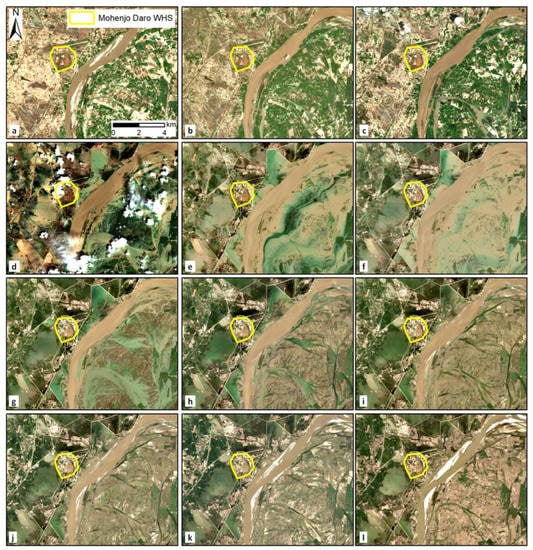
Figure 8.
Sentinel-2 time series of the area of Mohenjo Daro WHS (site boundary marked by yellow polygon) showing the spatial and temporal evolution of floods between 12 July and 30 October 2022, and in particular: (a) 12 July; (b) 1 August; (c) 11 August; (d) 26 August; (e) 31 August; (f) 5 September; (g) 10 September; (h) 15 September; (i) 20 September; (j) 25 September; (k) 5 October; (l) 30 October. Contains Copernicus Sentinel-2 data, 2022.
The time series shows that the WHS itself was spared from the floods which instead invested a large part of the surrounding countryside, except for some sectors in the eastern, southern and north-western sides where partial flooding, water stagnation and increased water content occurred. This evidence finds a good match with the Normalized Difference Water Index (NDWI) and the Normalized Difference Moisture Index (NDMI) values measured by Hegyi and Agapiou (2023) [9] using the same Sentinel-2 image collected on 31 August. Furthermore, the accessibility to the site was definitely affected, with waters first and mud then obstructing numerous access roads to Mohenjo Daro. Therefore, these data further substantiate the preliminary hypothesis presented in the UNOSAT focus report [26] and highlight the temporal frame of the floods and their persistence around the site.
In this respect, the integrated use of Sentinel-2 timelapse and the Sentinel-1-based GFM products between 30 August and 5 October allows for a better understanding and spatial extent quantification of the areas where waters have penetrated and remained longer versus the areas that were not affected by floods (Figure 9). While Sentinel-1 captured the peak inundation on 30 August and 3 September (Figure 9a,c), a significant decrease of flood water extent is observed on 8 September, mainly in the fields on the left riverbank (Figure 9e), and then across most of the landscape between 15 and 20 September (Figure 9i,k). The GFM products are more effective than the visual inspection of Sentinel-2 images in marking the large flooded areas persisting nearby until the end of October, and particularly south-west of the WHS (Figure 9l–p).
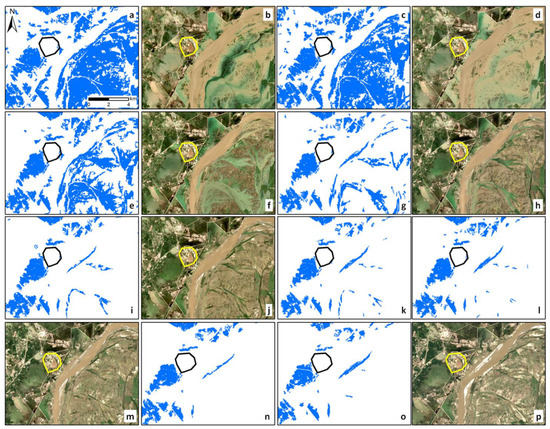
Figure 9.
Time-lapse of flooding around Mohenjo Daro WHS (site boundary marked by yellow and black polygons) by integrating Sentinel-2 (S2) and GFM products: (a) GFM, 30 August; (b) S2, 31 August; (c) GFM, 3 September; (d) S2, 5 September; (e) GFM, 8 September; (f) S2, 10 September; (g) GFM, 11 September; (h) S2, 15 September; (i) GFM, 15 September; (j) S2, 20 September; (k) GFM, 20 September; (l) GFM, 23 September; (m) S2, 25 September; (n) GFM, 27 September; (o) GFM, 2 October; and (p) S2, 5 October 2022. Contains Copernicus Sentinel-2 data, 2022, and CEMS GFM products, 2022.
This evidence is potentially significantly relevant for the WHS conservation. Despite the progressive withdrawal of the waters from 10 September onwards, this large sector south-west of the WHS characterized by cultivated fields and not by a space used for the collection of excess river water, remains almost completely flooded for much longer. Analyzing the AW3D30 elevation data (Figure 10a), it transpires that this sector is located in a topographic depression (height of 48 m; Figure 10c). As a stagnant water body (Figure 10b,d), it may facilitate saline efflorescences and water capillarity, which in the short term could be hazardous for the conservation of the mud-brick structures at Mohenjo Daro. Therefore, one of the key conclusions from the satellite-based impact assessment is that recovery actions should encompass not only the removal of muddy terrain from access roads, but also the drying of stagnant water bodies in proximity of the site.
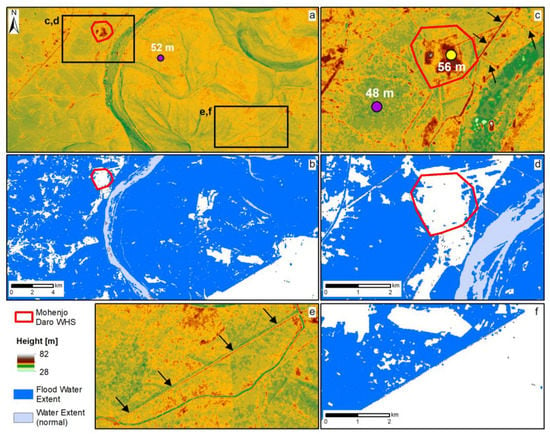
Figure 10.
(a) Topography according to ALOS AW3D30 DEM and (b) flood water extent product generated by UNOSAT (2022) [84] from Sentinel-2 image collected on 31 August 2022 (cf. the original image displayed in Figure 7b and Figure 8e) for the area of Mohenjo Daro WHS (site boundary marked by red polygon) and the surrounding landscape. The black polygons in (a) show the extent of the zoomed views on: (c,d) the WHS with indication of reference height values and the infrastructures acting as flood water barriers (black arrows), and (e,f) the south-easternmost part of the alluvial plain with indication of Sagyoon Loop Band embankment (black arrows). Contains Copernicus Sentinel-2 data, 2022, and CEMS GFM products, 2022.
Furthermore, the comparison between the flood water extent close to WHS and the topographic relief in AW3D30 (Figure 10a–d) highlights the presence of horizontal lines that sharply mark the boundaries of the flooded areas (see arrows in Figure 10c). Similarly, this happens in the south-easternmost part of the alluvial plain on the left riverbank (Figure 10e,f). The integrated analysis of satellite and cartographic data clarifies that this effect is due to the anthropogenic infrastructures (i.e., the outer bunds and stone pitched t-spurs mentioned in Section 2.3.1) and the causeway in the vicinity of Mohenjo Daro, as well as the embankment known as Sagyoon Loop Band in the south-eastern area. All these infrastructures acted as flood water barriers.
3.1.2. Makli Necropolis and Thatta Mosque
The impact assessment of the Makli necropolis and the Shah Jahan mosque of Thatta was undertaken for both the sites together due to their mutual proximity and similarity of environmental factors. The integrated use of SAR and optical satellite imagery confirmed that both places were not affected by the heavy Indus River floods that occurred in summer 2022. This, in some respect, was expectable given their distance from the river (nearly 11 km for the necropolis and 8 km for the mosque) and their topographic position (approximately 22 and 20 m height, respectively, versus 10 m in the alluvial plain) (Figure 11a and Figure 12).
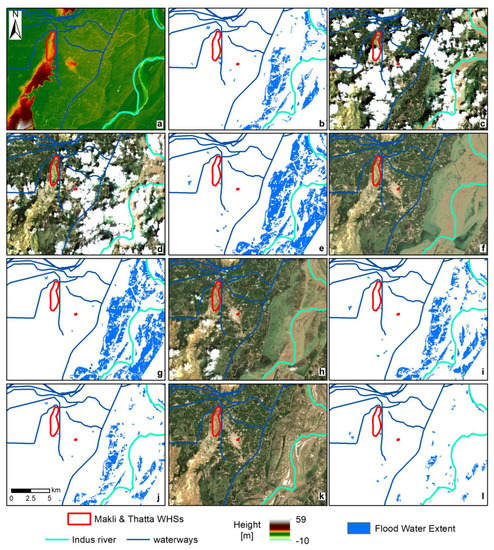
Figure 11.
(a) Topography of Makli Necropolis and Thatta mosque WHSs (site boundary marked by red polygon) and the surrounding landscape according to ALOS AW3D30 DEM. Timelapse of flooding by integrating Sentinel-2 (S2) images and GFM products: (b) GFM, 30 August 2022; (c) S2, 31 August and (d) 05 September; (e) GFM, 8 September; (f) S2, 10 September; (g) GFM, 11 September; (h) S2, 20 September; (i) GFM, 20 and (j) 23 September; (k) S2, 30 September; (l) GFM, 2 October. Contains Copernicus Sentinel-2 data, 2022, and CEMS GFM products, 2022.
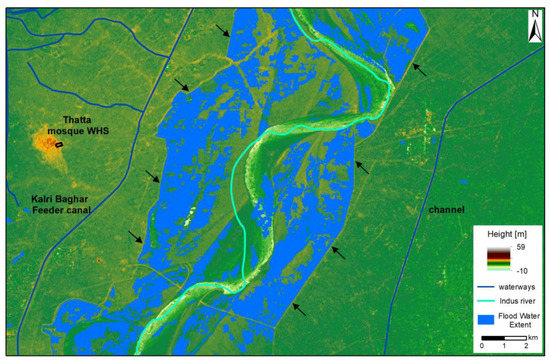
Figure 12.
Flood water extent as per the GFM product generated from the Sentinel-1 image collected on 8 September 2022 (cf. Figure 11e), overlapped onto the topography according to ALOS AW3D30 DEM of the floodplain of the Indus River in the area of Thatta mosque WHSs. Black arrows indicate the sharp boundaries of flood waters confined by embankments acting as physical barriers to further inundation. Contains CEMS GFM products, 2022.
The integration of Sentinel-1 and Sentinel-2 acquisitions made it possible to cover the entire period from late June until the end of October (Figure 11) and overcome the visibility issue due to high cloud density, in particular between 22 July and 5 September when the waters started to rise. Indeed, the GFM product on 30 August clearly shows the initial inundation in the floodplain (Figure 11b) that the Sentinel-2 image on 31 August only allows to infer from the few areas not obscured by clouds (Figure 11c). At that time, the raised waters in the Indus River were the result of river discharge from the upstream floods that had already affected the northern provinces. Makli necropolis and Thatta are located more than 300 km south of Mohenjo Daro, so it is expectable that, compared to the timing of the floods hitting the Larkana region, the peak inundation phase here was delayed of about a week and lasted for ten days more. The GFM products on 8 and 11 September, as well as the Sentinel-2 image on 10 September, temporally constrain the peak inundation (Figure 11e–g). The first image capturing waters starting to evacuate the floodplain is the Sentinel-2 collected on 20 September (Figure 11h), alongside the GFM produced on the same day (Figure 11i). On 30 September (Figure 11k), flood waters left a thick pack of muddy soil for quite a long time (at least until 25 October).
The reconstruction of the spatial and temporal evolution of floods clarifies the reason why waters did not reach the WHS sites and cause disruption or impact on their accessibility. A closer look at the GFM product on 8 September during the peak inundation in the area of the floodplain (Figure 12) reveals that the waters of the Indus River were confined both on the eastern and western sides at a sufficient distance from the urban centers. The remarkably regular, almost straight boundaries of the flood water extent indicate the presence of anthropogenic structures, possibly embankments, that acted as flood water barriers. The latter were presumably specifically designed to limit the impact of river floods. This hypothesis is confirmed by the integration of the cartographic data which highlighted the presence of a series of embankments along both the riverbanks, backed by large drainage channels: the Kalri Baghar Feeder to the west and a second minor channel to the east (Figure 12).
Therefore, the conclusion is that this double water control system certainly played an important role in preventing damage to the towns and villages as well as the cultural heritage and WHS sites of the region.
3.1.3. Kafir Kot
The Sentinel-2 timelapse taken between 2 June and 9 December 2022 (Figure 13 and Figure 14) suggests the occurrence of a nearly similar situation at Kafir Kot as observed around Mohenjo Daro, albeit with a slightly different timeline. Higher levels of river waters were already observed on 22 and 27 June, whereas the first clear-sky image showing inundation due to the flood event dates on 11 August (Figure 13c). The peak of inundation was captured in the image collected on 10 September (Figure 14a) and waters persisted until at least 20 September before retreating and leaving muddy fields as observed on 30 September. The situation appears to have been brought back to normal on 24 November.
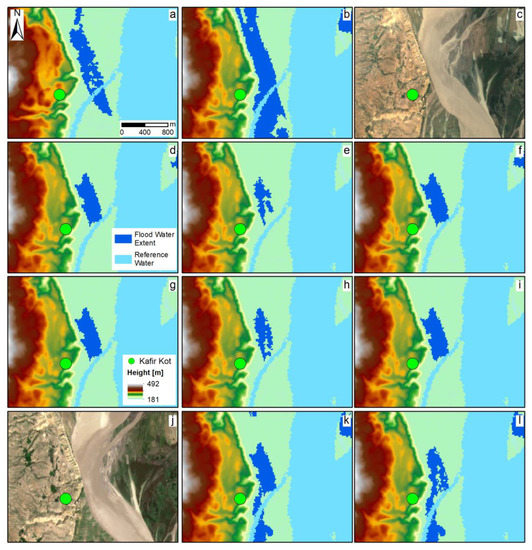
Figure 13.
Timelapse of flooding around the fortress of Kafir Kot by integrating Sentinel-2 (S2) and GFM products: (a) GFM, 1 August 2022; (b) GFM, 5 August; (c) S2, 11 August; (d) GFM, 12 August; (e) GFM, 13 August; (f) GFM, 17 August; (g) GFM, 24 August; (h) GFM, 25 August; (i) GFM, 29 August; (j) S2, 31 August; (k) GFM, 5 September; (l) GFM, 6 September. Contains Copernicus Sentinel-2 data, 2022, and CEMS GFM products, 2022.
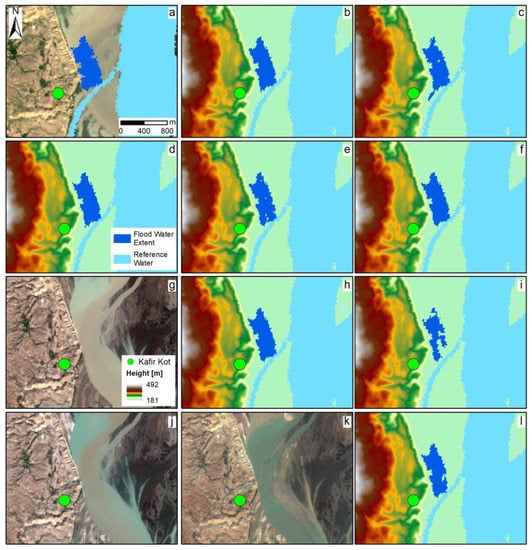
Figure 14.
Timelapse of flooding around the fortress of Kafir Kot by integrating Sentinel-2 (S2) and GFM products: (a) S2 and GFM, 10 September 2022; (b) GFM, 17 September; (c) GFM, 18 September; (d) GFM, 22 September; (e) GFM, 30 September; (f) GFM, 4 October; (g) S2, 5 October; (h) GFM, 11 October; (i) GFM, 12 October; (j) S2, 15 October; (k) S2, 20 October; (l) GFM, 23 October. Contains Copernicus Sentinel-2 data, 2022, and CEMS GFM products, 2022.
Nearly the same conclusions can be drawn using GFM maps (Figure 13 and Figure 14), albeit with some differences. Sentinel-1 images captured an increase of river waters close to the hills where the Kafir Kot is built onto already between 1 and 5 August (Figure 13a,b), i.e., one week before Sentinel-2. The flood water patterns on 5 and 6 September GFM products (Figure 13k,l) corroborate the observation made with Sentinel-2 about the growing inundation in the floodplain along the right bank. The pattern becomes smaller on 10 September (Figure 14a) and remains almost equal in the following scenes (Figure 14b–l), thus confirming that the inundation peak had been already overcome and no further expansion occurred.
Despite the severity of the event, thanks to its high altitude (around 290 m vs. 197 m of the floodplain), the site of Kafir Kot was not affected by flood waters (Figure 13 and Figure 14). On the other hand, given the flood water extent reached during the inundation across the floodplain, a local assessment of the accessibility to the archaeological area was needed (Figure 15 and Figure 16). Accounting for the limitation in detail definition due to the 10 m spatial resolution of Sentinel-2 imagery and the narrowness of the feature to observe, Sentinel-2 scenes collected during the peak period, i.e., 31 August and 10 September (Figure 13j and Figure 14a), suggest that flood waters have not impacted the main road leading to the site, although they approached very closely the road at the junction point with the path leading up to the site. A confirmation comes from the spectral analysis by selected points (Figure 16a). While the spectral curve of the point located in the floodplain at a close distance from the road embankment shows a clear pattern due to flooding starting from 11 August, the curve of the point located at the road junction not only is spectrally different, but also does not change throughout the whole observation period from 27 June to the end of October (Figure 16b).
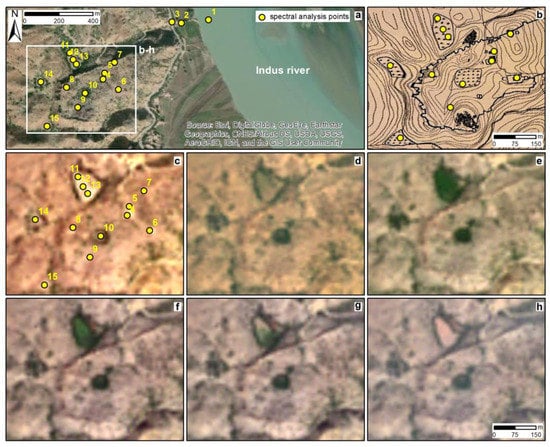
Figure 15.
(a) Kafir Kot fortress overlooking the Indus River as depicted in ArcGIS basemap image and (b) site map from the Archaeological Survey of India (1921–1922) [85], with location of the points of interest for which spectral analysis was undertaken throughout the Sentinel-2 images collected on: (c) 27 June; (d) 11 August; (e) 31 August; (f) 5 October; (g) 15 October; (h) 25 October. The white polygon in (a) shows the extent of the zoomed views in the other subfigures. Contains Copernicus Sentinel-2 data, 2022. Notation of the points of interest: 1—Indus River; 2—floodplain close to the road; 3—road at the junction with the path leading up to the fortress of Kafir Kot; 4—Temple A; 5—Temple B; 6—Temple C; 7—Temple D; 8—other structures on the western side; 9—other structures on the south-western side; 10—rounded-shape area inside the fortress south-west of Temple A; 11–13—low-land sector north of the fortress, northern, central and southern portions, respectively; 14—low-land sector north-western of the fortress; 15—low-land sector south-western of the fortress.
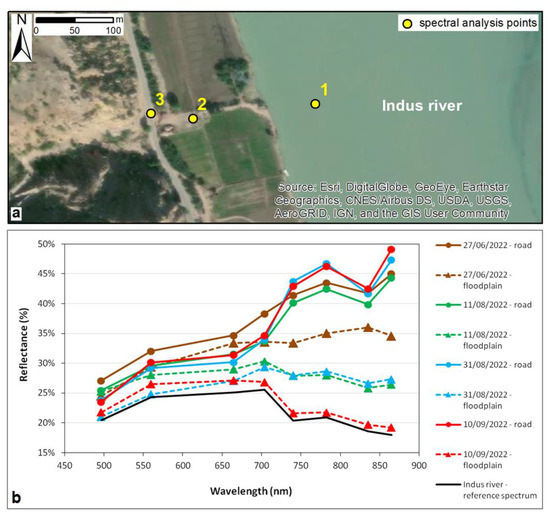
Figure 16.
Spectral analysis of the flooding/non-flooding condition of (a) the points of interest located (1) in the Indus River, (2) in the floodplain at a close distance from the road embankment and (3) on the road at the junction with the path leading up to the fortress of Kafir Kot (see wider location in Figure 15), via direct comparison between their (b) spectral curves extracted from the Sentinel-2 images collected on 27 June, 11 August, 31 August and 10 September 2022.
The spectral analysis is also helpful to clarify the presence and type of surface changes observed both inside and outside the fortress wall. A careful inspection of Sentinel-2 images (Figure 15c–h) reveal clear change patterns since 11 August in two of the four areas that the cartographic map published in 1921–1922 [85] marks as low-land sectors with dense vegetation (Figure 15b). Both the areas became greener as soon as the floodplain was inundated (Figure 15e), and their spectral curves took the typical shape of vegetation. Therefore, the hypothesis is that vegetation grew as the surface effect of rain precipitation and water accumulation. However, the temporal trend of their respective spectral signature was different (see Appendix B). The rounded-shape area inside the fortress located south-west of Temple A was completely dry and poor in vegetation on 27 June (Figure 15c), to become completely green since 11 August (Figure 15d) and lasting so until the end of October (Figure 15h). On the contrary, the low-land sector located outside and north of Kafir Kot started becoming green along the borders only on 11 August (Figure 15d) and appeared to be completely green 20 days later on 31 August (Figure 15e). At that time, the spectral curves of both the areas were almost the same (see Appendix B, Figure A1, Figure A2, Figure A3 and Figure A4), thus suggesting that the outside low-land sector too was covered by vegetation. However, one month later, and precisely on 5 October, the sector started becoming lighter green (Figure 15f), with some differentiation from north to south (i.e., from bright brown to lighter to darker green tones). On 15 October, the northern part was spectrally as it was on 27 June (Figure 15g and Appendix B Figure A1), whereas by 25 October the whole low-land sector reached back the same spectral signature as prior to the event (Figure 15h and Appendix B Figure A2 and Figure A3). This evidence therefore suggests that the low-land sector north of the fortress was inundated by water stagnation and gradually dried out over October. The rounded-shape area located inside the fortress instead remained vegetated for the whole period (Figure 15d–h and Appendix B Figure A4). Even if this was due to water stagnation, the surface effect captured from satellite was the vegetation growth and persistence. In conclusion, while there is no spectral signature suggesting impacts on the temples due to the heavy rain that occurred between August and September (see Appendix B Figure A5, Figure A6, Figure A7, Figure A8, Figure A9 and Figure A10), the only very minor impact was on some of the local lower-ground sectors. If the above site condition assessment is extended over the wider region up to at least the Chashma Barrage located few kilometers south of Kafir Kot [65], it can be noted that the GFM products delineate well the flood water extent confined within the quasi-regular-shaped basin created by the local embankments and the barrage itself. During the 2022 summer flood, the Chashma Barrage played an important role in protecting the surrounding area from uncontrolled water flooding, and contributed to prevent inundation of the road leading to Kafir Kot.
3.2. Ground-Truthing
A step forward of the present methodology compared to international mapping efforts and the very recent literature (e.g., [9]) was the integration of the remote sensing-based analysis with a detailed assessment on the ground. The latter allowed to obtain more fine-tuned information on the effect of the 2022 summer flooding at the selected sites.
3.2.1. Mohenjo Daro
Ground-truthing confirms that the 2022 floods caused considerable damage in Mohenjo Daro across the site (Figure 17A–D). Likewise, standing water along the front walls of the site can be observed in Figure 17D where restoration/repair work was already underway. This information integrates well with the observations made from satellite data. While the site was surrounded by flood waters and permanent water bodies for weeks, inside its perimeter, heavy rains, stagnation of water and increase in soil moisture contributed to wall collapses. The ground-truthing activities conducted by the local staff working at Mohenjo Daro also confirmed the difficulty of accessing the site during the floods, as suggested by the analysis of the Sentinel-1 and Sentinel-2 imagery. Accessibility to the site is indeed a crucial component for early response and site preservation, as damage or obstruction to the roads does not allow access, and therefore for the quantification or prevention of any further damage caused to the monuments within the site.
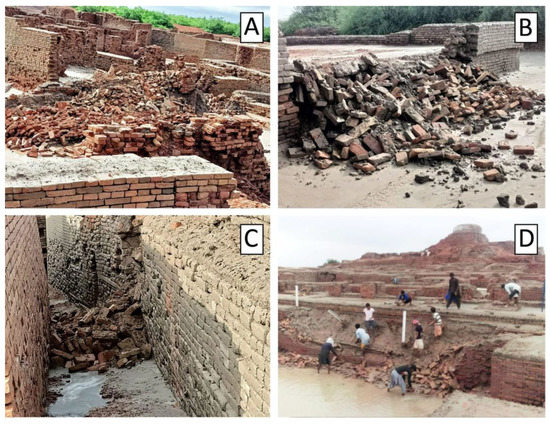
Figure 17.
Ground-truthing photographs taken at the UNESCO World Heritage Site of Mohenjo Daro, showing: (A–C) collapsed walls following the heavy rains and floods and (D) restoration and protection of the ancient walls against flooding and water stagnation.
3.2.2. Makli Necropolis
The ground-truthing activities confirmed the remote sensing results, i.e., that the 2022 summer floods have not directly damaged the Makli Necropolis. However, Figure 18 shows clearly that depressions or low-lying areas nearby were completely filled with water due to the heavy rainfall, thus resulting in stagnant water at a close distance to the WHS.
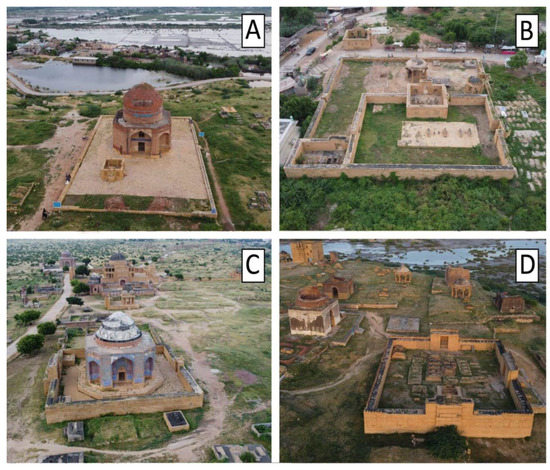
Figure 18.
The UNESCO World Heritage Site of Makli Necropolis. (A–D) General view of the site and the flooded areas in the surrounding landscape.
Such extreme rainfall events followed by the riverine flooding significantly increased the moisture content into the porous parts of the properties causing deterioration of cultural heritage materials and structures such as mud-bricks or baked bricks. Moreover, the fieldwork also revealed that groundwater may have risen due to the heavy rains and this may increase the risk of the walls becoming wet and eventually being susceptible to collapse.
3.2.3. Shah Jahan Mosque of Thatta
The ground-truthing activities at the site suggested that no new damage emerged as a consequence of the 2022 heavy rainfall and floods. However, some considerations about the potential impact of such events in the longer term can be made. Normally, 93 mm rainfall accumulates in the month of July and August in Thatta, whereas in 2022, a total of 505 mm rainfall was recorded during the same months. If this circumstance repeated over time, such a substantial increase may contribute to worsening current structural issues already documented at the site. This is suggested by the field photographs taken in collaboration with the local authorities which showed significant cracks in the vaults (Figure 19A,B) or the collapse of the tiles revetment and the bricks of the building facade (Figure 19C,D).
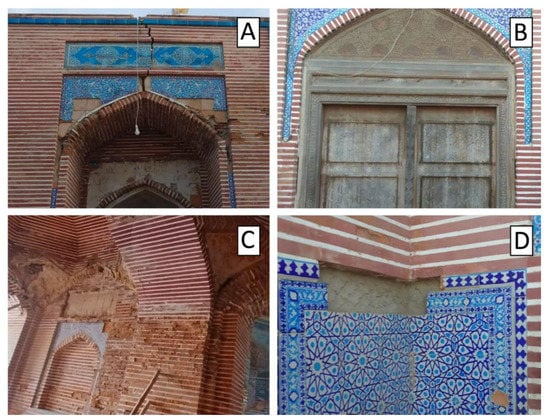
Figure 19.
Ground-truthing photographs taken at the UNESCO World Heritage Site of Shah Jahan mosque of Thatta, showing: (A,B) the cracks in the vaults and (C,D) the collapsed bricks and tiles.
In this case, the application of an integrated methodology including remote sensing data and ground-truthing revealed its effectiveness compared to other approaches which privileged only one method. While, in fact, the dramatic floods monitored through Copernicus datasets did not affect the site itself, the heavy rain documented through the fieldwork activities potentially impacted on the already existing issues at the site. The latter, however, could not have been observed from satellite, so only the integration with ground-truthing could unveil this potential threat.
3.2.4. Kafir Kot
As inferred from satellite data, the ground-truthing activities at Kafir Kot revealed very limited issues affecting the site. The archaeological area remained protected from the 2022 floods thanks to its considerable height from the surrounding areas and the river. However, the integrated use of UAV high-resolution photos and field survey (Figure 20A,B) confirmed the water accumulation in the spots previously identified by remote sensing data, both inside and outside the site due to the heavy rain (Figure 20B,C).
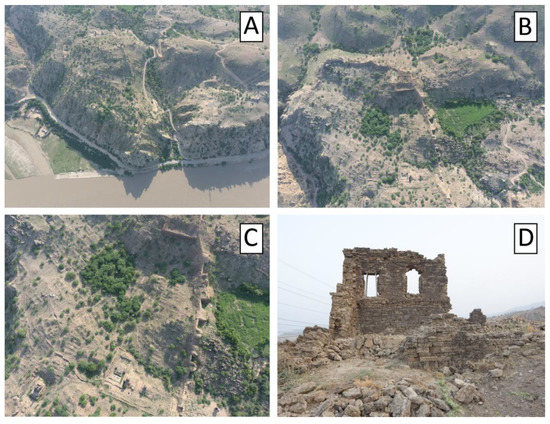
Figure 20.
UAV photographs documenting the condition of the fortress of Kafir Kot in the aftermath of the 2022 summer floods. (A–C) General view of the site and the flooded areas in the surrounding landscape; (D) detailed view of one of the buildings at the site.
4. Discussion
This study provides a simple and feasible integrated methodology to assess impacts of extreme and catastrophic floods in archaeological and cultural heritage sites through the case study of the 2022 summer floods in Pakistan. The methodology and analysis are shaped and undertaken through the lens of an end-user.
The results of the proposed approach highlight a series of elements relating to the methodology illustrated above: (1) Multidisciplinary collaboration; (2) Types of source and data acquisition methods; (3) Site management.
4.1. Multidisciplinary Collaboration
The final assessment of the flood impacts on each WHS was achieved via a continuous exchange of feedback between the remote sensing and satellite imagery analysts, the archaeologist and the geologist, which is characteristic of the co-working approach.
While the remote sensing and satellite image analysts were collecting Sentinel-2 images and Sentinel-1-based GFM products, the geologist gathered all the cartographic information useful to interpret certain features. Then, the archaeologist and the satellite imagery analyst analyzed the satellite images and products, and provided preliminary interpretation on the effect of the floods. This information was immediately shared with the geologist who, in collaboration with the archaeologist and the personnel working at the WHSs, performed an in-depth ground-truthing analysis to validate the satellite evidence. Therefore, what was experimentally tested in this research was precisely the intended workflow that ideally should happen during emergencies, in the aftermath and in the following weeks.
Therefore, to properly perform this type of activity, it is always advisable to organize small teams with at least one expert for each required skill (e.g., image processing, site detection, geological setting, landscape feature interpretation, conservation assessment). However, the size of the teams may vary, depending on variables such as the number and dimension of site(s) to be considered. For example, for a single large site or a small number of different sites spread across regions as in the case of our study, one or two remote sensing and satellite imagery analysts, one archaeologist and one geologist may be sufficient, while in the case of dozen(s) of sites up to an entire province or even at a country level, more figures covering each skill will be necessary. The approach is therefore scalable. Moreover, considering the substantially different expertise of all the professionals involved, it is advisable that a basic knowledge of the different disciplines and a common language are shared across the team.
To effectively transfer this working model to an organizational model, it is envisaged that the end-user institutions listed in Table 1 could be equipped with a similar team composition and the respective basic skills.
4.2. Types of Source and Data Acquisition Methods
In addition to the benefit of a multidisciplinary collaboration, the effectiveness of our methodology was based on the use of open-access products and tools for data acquisition, processing and interpretation. These also contributed to reducing the necessary time and increasing the feasibility of the approach.
Cartographic data can be easily collected from both publications and national archives. This is particularly important for end-users working for state or academic institutions as well as the UNESCO WHS staff. Our recommendation is that a digital archive can be created to collect together topographic, political, historical and geological maps of the heritage sites and the neighborhood region, to be ready for use during emergencies.
Satellite imagery and derived products such as Sentinel-2 and GFM provided by the Copernicus program are free and open and, thanks to the support of remote sensing and satellite image analysts, can be easily eploited by final users for purposes of rescue archaeology, monitoring and safeguard planning. In this respect, it is to be noted that, except for Mohenjo Daro WHS, none of the case studies were specifically included within the areas requested by the Pakistani government for emergency mapping via international support. In this respect, the present research showcases how the inclusion of key heritage assets in such mapping and monitoring efforts would be very beneficial, and thus advocates for the recommendation that local site managers as well as higher-level end-users (such as those listed in Table 1) may be proactive in requesting the access to these satellite services for damage assessment.
The products tested in this research may represent a useful preliminary tool for site managers to retrieve an initial map of the damage to be then integrated with ground-truthing, thus allowing to conduct first aid actions as well as medium-term safeguarding and conservation measures. Furthermore, the methodology makes the most out of tasked regular satellite acquisitions in the weeks to months after the end of the event, thus allowing the long-term monitoring of the flood damage and supporting the drafting of safeguarding strategies for future scenarios. Yet, by comparing early cartography and historical imagery and providing a reconstruction of the historical trend, it is possible to understand the frequency of similar catastrophic events at each cultural heritage place, and therefore prioritize specific threats in the implementation of mitigation strategies and funding allocation.
Ground-truthing of course represents a crucial final step of the methodology, providing conclusive results about the damage. Fieldwork activities conducted by archaeologists and geologists should always be prioritized if safety and security conditions allow. However, the example shown in Kafir Kot showcases the advantage of proximity remote sensing such as UAV, which is becoming increasingly accessible in terms of equipment costs and is advantageous when logistics and safety issues do not allow accessibility to the survey areas.
4.3. Site Management
Our study emphasizes how flooding may represent a type of factor linked to climate change [86] requiring more attention and dedicated space within the management plans of UNESCO WHSs, as well as in the implementation programs for the conservation of non-UNESCO sites.
In the case of Mohenjo Daro, the latest conservation reports were issued right after the 2010, 2011, and 2012 flooding events. Both the 2011 SOC (see Table 2) and the 2012 Periodic Reporting Cycle 2 Section II [87] recognized the potential threats caused by floods and also stressed the need for creating a boundary wall or fence to protect the site and for updating the risk management plan. However, the 2022 floods demonstrated that much still needs to be implemented. Based on the results of our study, the construction of boundary walls around the site, as well as of walls or other types of infrastructure to protect the access routes from flooding, is highly recommendable. Such protection measures are also linked to the necessity of updating the DRM plan which, based on the outcomes of the present study, should ideally also take into consideration all types of risk related to climate change and foresee the use of satellite data by trained technicians and site staff. The release of a new SOC report embedding the current understanding of these issues and needs at the site is also highly recommendable.
In the case of Makli Necropolis, both a preliminary management plan and a system for protecting and monitoring potential damage to the site have already been implemented (see Table 3). However, according to the UNESCO SOC reports, erosion and siltation have represented a major issue at Makli since the earliest monitoring in 2006, although this issue seems to still be affecting the site, and its effects are now increased by climate change events like the 2022 floods. As expected, floods per se are not accounted for as a threat because of the low probability that the site can be flooded. On the other side, as highlighted in the last joint World Heritage Centre/ICOMOS Mission Report (2019) [59], while a disaster response or emergency preparedness plan was not in place at that time, there was a Master Plan addressing some concrete measures in case of floods, although no protocols were available, for instance, to integrate emergency responders in case of a disaster. Therefore, based on the methodology proposed in this paper, a recommendation could be to issue the final management plan for the site including DRM [88], strengthening effort for protecting the site against climate change-related effects and also investing in trained site staff. If this mechanism was in place, it would make satellite data become part of the emergency response and decision-making process.
The Shah Jahan mosque of Thatta remained unscathed by the effects of the 2022 floods. This is also thanks to the embankment infrastructure and secondary channels which, as shown by the satellite images, have greatly contributed to the protection of the entire city of Thatta, as well as Makli. Such a strategy represents a best practice that should be replicated in all the flood-prone areas, in particular, where infrastructures including heritage buildings are located along riverbanks or close to the river.
For example, a similar strategy may have assured the integrity of the roads at Mohenjo Daro. Although similar infrastructures necessitate substantial investments, it is recommended that planning and construction of such embankments could also account for the presence of cultural heritage sites and monuments of national interest, so that these infrastructures may act as shelters for these assets too. In this respect, the role of national authorities in charge of heritage protection such as the Directorate General of Archaeology and Museums National Heritage and Culture Division to raise awareness and contribute to planning is crucial. Such a participatory process and following actions appear even more timely given the evidence of increasing extreme climate change-related events that are expected to impact on Pakistan and other countries globally in the forthcoming years [20,64,89,90]. Such hazards may in fact cause severe, and often irreversible, damage to the country’s heritage.
5. Conclusions
The analysis presented in this paper emphasizes how the 2022 summer floods had an impact on cultural heritage in the affected regions in Pakistan, albeit with some important differences that relate not only to intrinsic environmental characteristics of the properties (e.g., topography, distance from Indus River) but also to anthropogenic factors of the surrounding landscape (e.g., embankments, defense structures). While it is important to assess the condition of the archaeological remains and ancient monuments, flood damage assessment in heritage properties should also account for the impact on site accessibility. In Mohenjo Daro WHS, floods nearly completely surrounded the site and created water bodies in local topographic depressions that could exacerbate the risk of saline efflorescences and water capillarity, in addition to the detrimental effect of abundant precipitation and water table rise on mud-brick structures. Embankments instead contributed to prevent inundation in the areas of Makli Necropolis WHS and Thatta Mosque Tentative WHS. Whereas, the combination of simple spectral analysis methods and UAV survey confirmed the very limited impact on Kafir Kot fortress. If the present analysis was replicated for a wider and more distributed sample of sites, this type of exercise would lead to a country-scale assessment of the 2022 floods.
From a methodological and operational point of view, this research shows that a multidisciplinary collaboration between remote sensing and satellite image analysts, a geologist and an archaeologist using multispectral and SAR imagery and derived products such as Copernicus data, alongside cartographic data and ground-truthing, represents a useful and feasible approach for assessing the impact of extreme climate change-related events, such as floods, on cultural heritage across a country and, ideally, in other locations worldwide. The workflow and the demonstration presented in this paper aspire to act as a proof-of-concept of what could be achieved not only in post-disaster mapping situations but, more importantly, throughout the recovery period when the lessons learnt during a disastrous event should be taken on board to improve risk management plans.
In this respect, Copernicus products, both as original image time series and maps generated from them such as GFM in the context of CEMS, are valuable assets to retrieve an evidence base highlighting where to invest in and how to safeguard the local heritage and thus reduce the risk. While someone could argue that the spatial resolution of Sentinel-1 and 2 imageries may not always suit the scale of observation (which, however, was not the case in the present research), their temporal resolution and frequency of observation are absolutely advantageous to constantly monitoring the situation on the ground. Additionally, such products can be used by the end-users without detailed knowledge of software and data processing schemes. This work demonstrates the importance of the basic know-how of these datasets and being trained on how to access and use them.
Furthermore, different professionals should ideally compose heritage site management teams, so all the needed expertise is present and can contribute to the impact assessment and risk management. Therefore, we can conclude that the methodology illustrated in this paper is relatively easy to use for archaeologists, geologists and site managers in both UNESCO and non-UNESCO sites with basic skills, limited funding and constrained by a limited timeframe. If transferred to end-users, this methodology can be integrated into the current monitoring procedures implemented for both UNESCO sites (e.g., SOCs issuing) and the national sites in Pakistan and beyond.
In this respect, the present research should be contextualized in the wider process of facilitating the integration of space technologies to support the monitoring and documentation of cultural heritage, as it has been invested in by several organizations and space agencies in the last years (see e.g., the UNESCO-ESA “Open Initiative on the Use of Space Technologies to Support the World Heritage Convention”; [91]) and according to the paradigms promoted by the Committee on Earth Observation Satellites (CEOS) through its Working Groups on Disasters (WGD) and Capacity Building and Data Democracy (WGCapD).
Moreover, to disseminate the proposed satellite-based methodology, a feasible way forward would be via capacity building projects in which established co-working teams, encompassing archaeologists, geologists, heritage experts and satellite image analysts, will train end-users from national heritage institutions, commercial archaeology companies and academia [28]. This activity would be particularly useful in those countries with limited access and funding to support on-purchase facilities, and where local personnel lack advanced satellite remote sensing skills, as it was recently demonstrated, for instance, by the EDUU [92] and EAMENA [93] projects.
Author Contributions
Conceptualization, M.Y.K., D.T. and F.Z.; methodology, M.Y.K., F.Z., S.M. and D.T.; software: D.T.; formal analysis, M.Y.K., F.Z., S.M. and D.T.; investigation, M.Y.K. and F.Z.; resources, M.Y.K. and D.T.; data curation: D.T.; writing—original draft preparation, M.Y.K., F.Z. and D.T.; writing—review and editing, M.Y.K., F.Z., S.M. and D.T.; visualization, F.Z., S.M. and D.T. All authors have read and agreed to the published version of the manuscript.
Funding
This research received no external funding.
Data Availability Statement
Research conducted using Sentinel-1A and Sentinel-2A/B scenes sourced as open data from the Copernicus Open Access Hub. Google Earth images (© 2023 Maxar Technologies) were sourced and analyzed from Google Earth Pro. Global Flood Monitoring (GFM) maps are products of the Copernicus Emergency Management Service (CEMS) and were generated from the service accessed at https://portal.gfm.eodc.eu/login (accessed from 1 October to 15 December 2022).
Acknowledgments
We are thankful to Tahir Saeed from the Directorate of Archaeology and Museums for his cooperation and assistance regarding the field campaign, and Muhammad Suliman who is working at the Directorate of Archaeology and Museums, Peshawar, Khyber Pakhtunkhwa, for providing UAV data of Kafir Kot site. We are also thankful to Zahid Latif, Shahina and Zain Ul Abidin for their useful suggestions and assistance during this work. This work was also supported by the International Centre for Integrated Mountain Development (ICIMOD). The views and interpretations in this publication are those of the authors and they are not necessarily attributable to their organizations.
Conflicts of Interest
The authors declare no conflict of interest.
Appendix A
Lists of satellite data used to study the impacts of the 2022 summer floods on the sites of: Mohenjo Daro, Makli Necropolis, Shah Jahan Mosque of Thatta and the fortress of Kari Kot in Pakistan.

Table A1.
Sentinel-1/CEMS Global Flood Monitoring products (GFM) used over Mohenjo Daro. Notation: GRD—Ground Range Detected; IW—Interferometric Wide Swath; S1—Sentinel-1 (satellite 1A); VV—Vertical–Vertical.
Table A1.
Sentinel-1/CEMS Global Flood Monitoring products (GFM) used over Mohenjo Daro. Notation: GRD—Ground Range Detected; IW—Interferometric Wide Swath; S1—Sentinel-1 (satellite 1A); VV—Vertical–Vertical.
| Sensor/ Derived Product | Satellite | Format/ Processing Level | Imaging Mode | Polarization | Date of Acquisition | Observation Geometry | Absolute Orbit Number |
|---|---|---|---|---|---|---|---|
| Sentinel-1/GFM | S1A | GRD/raster | IW | VV | 30 August 2022 | descending | 44775 |
| 3 September 2022 | ascending | 44841 | |||||
| 4 September 2022 | descending | 44848 | |||||
| 6 September 2022 | descending | 44877 | |||||
| 8 September 2022 | ascending | 44914 | |||||
| 11 September 2022 | descending | 44950 | |||||
| 15 September 2022 | ascending | 45016 | |||||
| 18 September 2022 | descending | 45052 | |||||
| 20 September 2022 | ascending | 45089 | |||||
| 23 September 2022 | descending | 45125 | |||||
| 27 September 2022 | ascending | 45191 | |||||
| 30 September 2022 | descending | 45227 | |||||
| 2 October 2022 | ascending | 45264 |

Table A2.
Sentinel-2 imagery used over Mohenjo Daro. Notation: S2—Sentinel-2 (both satellites 2A and 2B); L2A—Bottom-Of-Atmosphere (BOA) corrected reflectance product.
Table A2.
Sentinel-2 imagery used over Mohenjo Daro. Notation: S2—Sentinel-2 (both satellites 2A and 2B); L2A—Bottom-Of-Atmosphere (BOA) corrected reflectance product.
| Satellite | Format/Processing Level | Date of Acquisition | Tile |
|---|---|---|---|
| S2A | L2A | 2 July 2022 | T42RVR |
| S2A | 12 July 2022 | ||
| S2A | 1 August 2022 | ||
| S2A | 11 August 2022 | ||
| S2B | 26 August 2022 | ||
| S2A | 31 August 2022 | ||
| S2B | 5 September 2022 | ||
| S2A | 10 September 2022 | ||
| S2B | 15 September 2022 | ||
| S2A | 20 September 2022 | ||
| S2B | 25 September 2022 | ||
| S2B | 5 October 2022 | ||
| S2A | 10 October 2022 | ||
| S2B | 15 October 2022 | ||
| S2A | 20 October 2022 | ||
| S2B | 25 October 2022 | ||
| S2A | 30 October 2022 |

Table A3.
Sentinel-1/CEMS Global Flood Monitoring products (GFM) used over Makli Necropolis and Thatta Mosque. Notation: GRD—Ground Range Detected; IW—Interferometric Wide Swath; S1—Sentinel-1 (satellite 1A); VV—Vertical–Vertical.
Table A3.
Sentinel-1/CEMS Global Flood Monitoring products (GFM) used over Makli Necropolis and Thatta Mosque. Notation: GRD—Ground Range Detected; IW—Interferometric Wide Swath; S1—Sentinel-1 (satellite 1A); VV—Vertical–Vertical.
| Sensor/ Derived Product | Satellite | Format/ Processing Level | Imaging Mode | Polarization | Date of Acquisition | Observation Geometry | Absolute Orbit Number |
|---|---|---|---|---|---|---|---|
| Sentinel-1/GFM | S1A | GRD/raster | IW | VV | 30 August 2022 | descending | 44775 |
| 3 September 2022 | ascending | 44841 | |||||
| 4 September 2022 | descending | 44848 | |||||
| 6 September 2022 | descending | 44877 | |||||
| 8 September 2022 | ascending | 44914 | |||||
| 11 September 2022 | descending | 44950 | |||||
| 15 September 2022 | ascending | 45016 | |||||
| 18 September 2022 | descending | 45052 | |||||
| 20 September 2022 | ascending | 45089 | |||||
| 23 September 2022 | descending | 45125 | |||||
| 27 September 2022 | ascending | 45191 | |||||
| 30 September 2022 | descending | 45227 | |||||
| 2 October 2022 | ascending | 45264 |

Table A4.
Sentinel-2 imagery used over Makli Necropolis and Thatta Mosque. Notation: S2—Sentinel-2 (both satellites 2A and 2B); L2A—Bottom-Of-Atmosphere (BOA) corrected reflectance product.
Table A4.
Sentinel-2 imagery used over Makli Necropolis and Thatta Mosque. Notation: S2—Sentinel-2 (both satellites 2A and 2B); L2A—Bottom-Of-Atmosphere (BOA) corrected reflectance product.
| Satellite | Format/Processing Level | Date of Acquisition | Tile |
|---|---|---|---|
| S2B | L2A | 27 June 2022 | T42RUN |
| S2A | 22 July 2022 | ||
| S2A | 31 August 2022 | ||
| S2B | 5 September 2022 | ||
| S2A | 10 September 2022 | ||
| S2A | 20 September 2022 | ||
| S2A | 30 September 2022 | ||
| S2B | 5 October 2022 | ||
| S2A | 10 October 2022 | ||
| S2B | 15 October 2022 | ||
| S2B | 25 October 2022 |

Table A5.
Sentinel-1/CEMS Global Flood Monitoring products (GFM) used over Kafir Kot. Notation: GRD—Ground Range Detected; IW—Interferometric Wide Swath; S1—Sentinel-1 (satellite 1A); VV—Vertical–Vertical.
Table A5.
Sentinel-1/CEMS Global Flood Monitoring products (GFM) used over Kafir Kot. Notation: GRD—Ground Range Detected; IW—Interferometric Wide Swath; S1—Sentinel-1 (satellite 1A); VV—Vertical–Vertical.
| Sensor/ Derived Product | Satellite | Format/ Processing Level | Imaging Mode | Polarization | Date of Acquisition | Observation Geometry | Absolute Orbit Number |
|---|---|---|---|---|---|---|---|
| Sentinel-1/GFM | S1A | GRD/raster | IW | VV | 1 August 2022 | descending | 44352 |
| 5 August 2022 | ascending | 44418 | |||||
| 12 August 2022 | ascending | 44520 | |||||
| 13 August 2022 | descending | 44527 | |||||
| 17 August 2022 | ascending | 44593 | |||||
| 24 August 2022 | ascending | 44695 | |||||
| 25 August 2022 | descending | 44702 | |||||
| 5 September 2022 | ascending | 44870 | |||||
| 6 September 2022 | descending | 44877 | |||||
| 10 September 2022 | ascending | 44943 | |||||
| 17 September 2022 | ascending | 45045 | |||||
| 22 September 2022 | descending | 45052 | |||||
| 29 September 2022 | ascending | 45118 | |||||
| 30 September 2022 | ascending | 45220 | |||||
| 4 October 2022 | descending | 45227 | |||||
| 11 October 2022 | ascending | 45293 | |||||
| 12 October 2022 | ascending | 45395 | |||||
| 23 October 2022 | descending | 45402 | |||||
| 1 August 2022 | ascending | 45570 |

Table A6.
Sentinel-2 imagery used over Kafir Kot. Notation: S2—Sentinel-2 (both satellites 2A and 2B); L2A—Bottom-Of-Atmosphere (BOA) corrected reflectance product.
Table A6.
Sentinel-2 imagery used over Kafir Kot. Notation: S2—Sentinel-2 (both satellites 2A and 2B); L2A—Bottom-Of-Atmosphere (BOA) corrected reflectance product.
| Satellite | Format/Processing Level | Date of Acquisition | Tile |
|---|---|---|---|
| S2B | L2A | 27 June 2022 | T42SYA, T42SYB |
| S2A | 11 August 2022 | ||
| S2A | 31 August 2022 | ||
| S2A | 10 September 2022 | ||
| S2B | 15 September 2022 | ||
| S2A | 20 September 2022 | ||
| S2A | 30 September 2022 | ||
| S2B | 5 October 2022 | ||
| S2B | 15 October 2022 | ||
| S2A | 20 October 2022 | ||
| S2B | 25 October 2022 | ||
| S2B | 4 November 2022 | ||
| S2B | 24 November 2022 | ||
| S2A | 29 November 2022 | ||
| S2A | 9 December2022 |
Appendix B
Spectral analysis of points of interest in Kafir Kot (see Figure 15 for precise geographic location inside and outside the site).
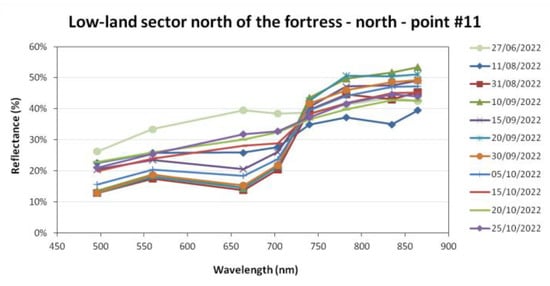
Figure A1.
Spectra of the low-land sector north of the fortress, northern portion, point #11, from Sentinel-2 imagery.
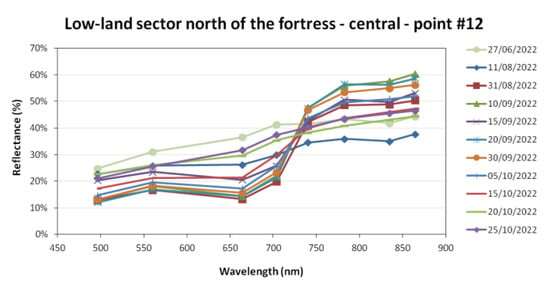
Figure A2.
Spectra of the low-land sector north of the fortress, central portion, point #12, from Sentinel-2 imagery.
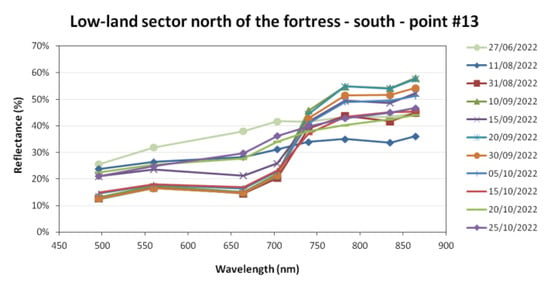
Figure A3.
Spectra of the low-land sector north of the fortress, southern portion, point #13, from Sentinel-2 imagery.
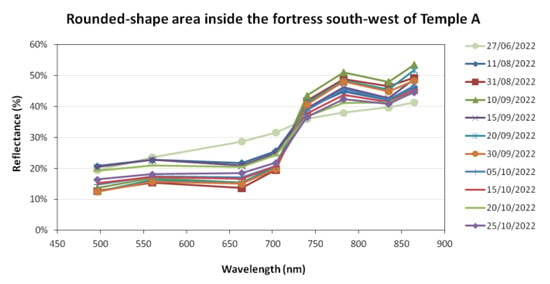
Figure A4.
Spectra of the rounded-shape area inside the fortress south-west of Temple A, point #10, from Sentinel-2 imagery.
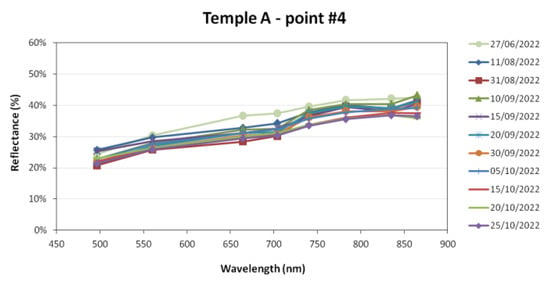
Figure A5.
Spectra of Temple A, point #4, from Sentinel-2 imagery.
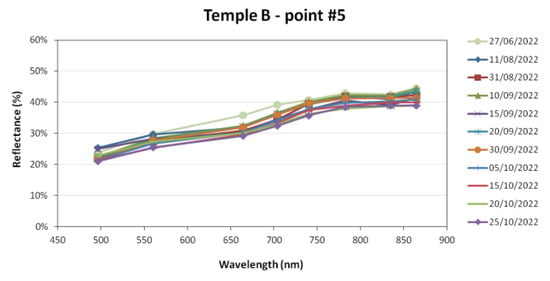
Figure A6.
Spectra of Temple B, point #5, from Sentinel-2 imagery.
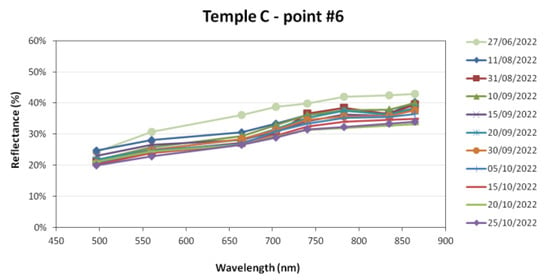
Figure A7.
Spectra of Temple C, point #6, from Sentinel-2 imagery.
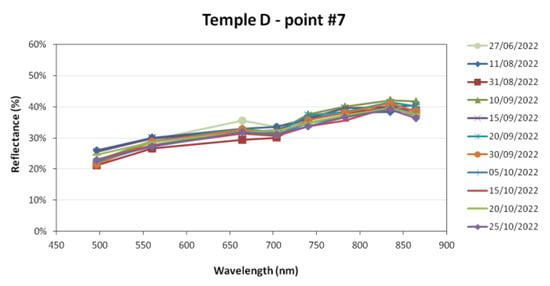
Figure A8.
Spectra of Temple D, point #7, from Sentinel-2 imagery.
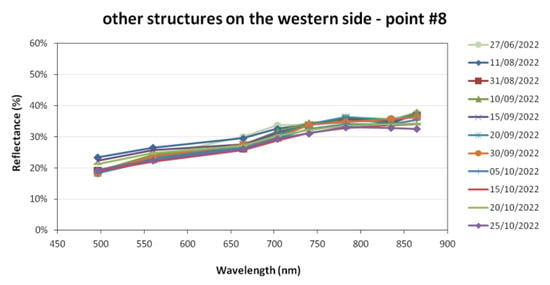
Figure A9.
Spectra of other structures on the western side, point #8, from Sentinel-2 imagery.
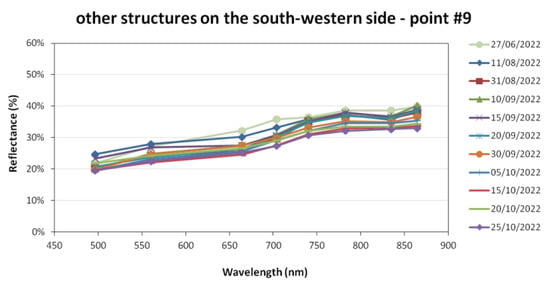
Figure A10.
Spectra of other structures on the south-western side, point #9, from Sentinel-2 imagery.
References
- Pryor, S.C.; Howe, J.A.; Kunkel, K.E. How spatially coherent and statistically robust are temporal changes in extreme precipitation in the contiguous USA? Int. J. Climatol. 2009, 29, 31–45. [Google Scholar] [CrossRef]
- Merz, B.; Blöschl, G.; Vorogushyn, S.; Dottori, F.; Aerts, J.C.J.H.; Bates, P.; Bertola, M.; Kemter, M.; Kreibich, H.; Lall, U.; et al. Causes, impacts and patterns of disastrous river floods. Nat. Rev. Earth Environ. 2021, 2, 592–609. [Google Scholar] [CrossRef]
- World Food Programme. Pakistan Flood Impact Assessment, September 2010—Pakistan|ReliefWeb; United Nations—World Food Programme: New York, 2010; Available online: https://documents.wfp.org/stellent/groups/public/documents/ena/wfp225987.pdf (accessed on 2 February 2023).
- Immigration and Refugeee Board of Canada. The Impact of the 2010 and 2011 Floods, Including on Mobility, Reconstruction, Housing and Shelter, Employment and Access to Food, 1 December 2011, PAK103865.E. Available online: https://www.refworld.org/docid/5072cc582.html (accessed on 2 February 2023).
- Kirsch, T.D.; Wadhwani, C.; Sauer, L.; Doocy, S.; Catlett, C. Impact of the 2010 Pakistan Floods on Rural and Urban Populations at Six Months. PLoS Curr. 2012, 4. [Google Scholar] [CrossRef] [PubMed]
- Abro, M.I.; Zhu, D.; Ali Khaskheli, M.; Elahi, E.; Aleem ul Hassan Ramay, M. Statistical and qualitative evaluation of multi-sources for hydrological suitability inflood-prone areas of Pakistan. J. Hydrol. 2020, 588, 125117. [Google Scholar] [CrossRef]
- Rasool, S.; Rana, I.A.; Ahmad, S. Linking flood risk perceptions and psychological distancing to climate change: A case study of rural communities along Indus and Chenab rivers, Pakistan. Int. J. Disaster Risk Reduct. 2022, 70, 102787. [Google Scholar] [CrossRef]
- Otto, F.E.; Zachariah, M.; Saeed, F.; Siddiqi, A.; Shahzad, K.; Mushtaq, H.; Arulalan, T.; Krishna, A.R.; Chaithra, S.T.; Clair, B.; et al. Climate Change Likely Increased Extreme Monsoon Rainfall, Flooding Highly Vulnerable Communities in Pakistan—World Weather Attribution; Utrecht University Repository: Utrecht, The Netherlands, 2022. [Google Scholar]
- Hegyi, A.; Agapiou, A. Rapid Assessment of 2022 Floods around the UNESCO Site of Mohenjo-Daro in Pakistan by Using Sentinel and Planet Labs Missions. Sustainability 2023, 15, 2084. [Google Scholar] [CrossRef]
- Arrighi, C. A Global Scale Analysis of River Flood Risk of UNESCO World Heritage Sites. Front. Water 2021, 3, 764459. [Google Scholar] [CrossRef]
- Voigt, S.; Giulio-Tonolo, F.; Lyons, J.; Kučera, J.; Jones, B.; Schneiderhan, T.; Platzeck, G.; Kaku, K.; Hazarika, M.K.; Czaran, L.; et al. Global trends in satellite-based emergency mapping. Science 2016, 353, 247–252. [Google Scholar] [CrossRef]
- Agapiou, A.; Lysandrou, V.; Hadjimitsis, D.G. Earth observation contribution to cultural heritage disaster risk management: Case study of Eastern Mediterranean open air archaeological monuments and sites. Remote Sens. 2020, 12, 1330. [Google Scholar] [CrossRef]
- Copernicus Services in Support to Cultural Heritage—Publications Office of the EU. Available online: https://op.europa.eu/en/publication-detail/-/publication/220f385f-76bd-11e9-9f05-01aa75ed71a1/ (accessed on 19 February 2023).
- Alfieri, L.; Bisselink, B.; Dottori, F.; Naumann, G.; de Roo, A.; Salamon, P.; Wyser, K.; Feyen, L. Global projections of river flood risk in a warmer world. Earth’s Futur. 2017, 5, 171–182. [Google Scholar] [CrossRef]
- Kulp, S.A.; Strauss, B.H. New elevation data triple estimates of global vulnerability to sea-level rise and coastal flooding. Nat. Commun. 2019, 10, 4844. [Google Scholar] [CrossRef] [PubMed]
- Haq, M.; Akhtar, M.; Muhammad, S.; Paras, S.; Rahmatullah, J. Techniques of Remote Sensing and GIS for flood monitoring and damage assessment: A case study of Sindh province, Pakistan. Egypt. J. Remote Sens. Space Sci. 2012, 15, 135–141. [Google Scholar] [CrossRef]
- Memon, A.A.; Muhammad, S.; Rahman, S.; Haq, M. Flood monitoring and damage assessment using water indices: A case study of Pakistan flood-2012. Egypt. J. Remote Sens. Space Sci. 2015, 18, 99–106. [Google Scholar] [CrossRef]
- Qamer, F.M.; Ahmad, B.; Abbas, S.; Hussain, A.; Salman, A.; Muhammad, S.; Nawaz, M.; Shrestha, S.; Iqbal, B.; Thapa, S. The 2022 Pakistan Floods: Assessment of Crop Losses in Sindh Province using Satellite Data; International Centre for Integrated Mountain Development (ICIMOD); Pakistan Agricultural Research Council’s (PARC): Kathmandu, Nepal, 2022. [Google Scholar] [CrossRef]
- Haq, M.; Said, R.; Rahmatullah, J.; Mohammad, S. Pakistan—Flood 2010 monitoring using MODIS data. In Proceedings of the 9th International Workshop of the CAS-TWAS-W Forum (2010 CTWF) on Climate and Environmental Changes and Challenges for Developing Countries, Beijing, China, 17–19 November 2010; Chinese Academy of Science: Beijing, China, 2010; pp. 17–20. [Google Scholar]
- Mirza, M.M.Q. Climate change, flooding in South Asia and implications. Reg. Environ. Chang. 2011, 11, 95–107. [Google Scholar] [CrossRef]
- Pakistan Floods 2022: Post-Disaster Needs Assessment (PDNA)|United Nations Development Programme. Available online: https://www.undp.org/pakistan/publications/pakistan-floods-2022-post-disaster-needs-assessment-pdna (accessed on 19 February 2023).
- UNESCO. Climate Change and World Heritage: Report on predicting and managing the impacts of climate change on World Heritage and strategy to assist State Parties to implement appropriate management responses. World Herit. Rep. 2007, 22, 1–55. [Google Scholar]
- Sabbioni, C.; Brimblecombe, P.; Cassar, M. The Atlas of Climate Change Impact on European Cultural Heritage—Publications Office of the EU; Anthem Press: London, UK, 2010; ISBN 978-92-79-09800-0. [Google Scholar]
- UNESCO. UNESCO World Heritage Centre—Document—State of Conservation of World Heritage Properties—A Statistical Analysis (1979–2013). Available online: https://whc.unesco.org/en/documents/134872 (accessed on 19 February 2023).
- UNESCO. Enhancing our Heritage Toolkit, Assessing Management Effectiveness of Natural. Available online: https://whc.unesco.org/en/series/23/ (accessed on 19 February 2023).
- UNOSAT. Preliminary Satellite-Derived Flood Assessment, Islamic Republic of Pakistan—8 September 2022. Available online: https://unosat.org/products/3352 (accessed on 19 February 2023).
- Mapping. COPERNICUS EMERGENCY MANAGEMENT SERVICE|Copernicus EMS—EMSR629: Floods in Pakistan. Available online: https://emergency.copernicus.eu/mapping/list-of-components/EMSR629 (accessed on 19 February 2023).
- Zaina, F.; Tapete, D. Satellite-Based Methodology for Purposes of Rescue Archaeology of Cultural Heritage Threatened by Dam Construction. Remote Sens. 2022, 14, 1009. [Google Scholar] [CrossRef]
- Agapiou, A.; Lysandrou, V. Remote sensing archaeology: Tracking and mapping evolution in European scientific literature from 1999 to 2015. J. Archaeol. Sci. Reports 2015, 4, 192–200. [Google Scholar] [CrossRef]
- Cunliffe, E.L.; de Gruchy, M.W.; Stammitti, E. Project {Development}—{Dam}(ned) archaeology. Int. Water Power Dam Constr. 2012, 64, 9. [Google Scholar]
- Khan, M.Y.; Zaina, F.; ul Abedin, Z.; Tariq, S.; Khan, M.J. Evaluation of risks to UNESCO World Heritage (WH) sites in Taxila, Pakistan using ground-based and satellite remote sensing techniques. J. Cult. Herit. 2022, 55, 195–209. [Google Scholar] [CrossRef]
- Possehl, G.L. The Indus Civilization: A Contemporary Perspective; Altamira Press: Walnut Creek, 2002. [Google Scholar]
- McIntosh, J. The Ancient Indus Valley: New Perspectives; ABC-CLIO: Santa Barbara, 2008. [Google Scholar]
- UNESCO. Archaeological Ruins at Moenjodaro—Gallery—UNESCO World Heritage Centre. Available online: https://whc.unesco.org/en/list/138/gallery/ (accessed on 19 February 2023).
- Marshall, J. Mohenjo-Daro and the Indus Civilization: Being an Official Account of Archaeological Excavations at Mohenjo-Daro Carried Out by the Government of India between the Years 1922 and 1927; Arthur Probsthain: London, UK, 1931. [Google Scholar]
- Mackay, E. Further Excavations at Mohenjo-Daro Being an Official Account of Archaeological Excavations at Mohenjo-Daro Carried out by the Government of India between the Years 1927- and 1931 Vol.I: Text|INDIAN CULTURE. Available online: https://indianculture.gov.in/ebooks/further-excavations-mohenjo-daro-being-official-account-archaeological-excavations-mohenjo-0 (accessed on 19 February 2023).
- UNESCO. UNESCO World Heritage Centre—State of Conservation (SOC) Search. Available online: https://whc.unesco.org/en/soc/?action=list&id_site=138 (accessed on 19 February 2023).
- UNESCO. UNESCO World Heritage Centre—List of Factors Affecting the Properties. Available online: https://whc.unesco.org/en/factors/ (accessed on 19 February 2023).
- UNESCO. UNESCO World Heritage Centre—State of Conservation (SOC 1991) Archaeological Ruins at Moenjodaro (Pakistan). Available online: https://whc.unesco.org/en/soc/1643 (accessed on 19 February 2023).
- UNESCO. UNESCO World Heritage Centre—State of Conservation (SOC 1995) Archaeological Ruins at Moenjodaro (Pakistan). Available online: https://whc.unesco.org/en/soc/2989 (accessed on 19 February 2023).
- UNESCO. UNESCO World Heritage Centre—State of Conservation (SOC 1997) Archaeological Ruins at Moenjodaro (Pakistan). Available online: https://whc.unesco.org/en/soc/2147 (accessed on 19 February 2023).
- UNESCO. UNESCO World Heritage Centre—State of Conservation (SOC 2006) Archaeological Ruins at Moenjodaro (Pakistan). Available online: https://whc.unesco.org/en/soc/1189 (accessed on 19 February 2023).
- UNESCO. UNESCO World Heritage Centre—State of Conservation (SOC 2007) Archaeological Ruins at Moenjodaro (Pakistan). Available online: https://whc.unesco.org/en/soc/1028 (accessed on 19 February 2023).
- UNESCO. UNESCO World Heritage Centre—State of Conservation (SOC 2011) Archaeological Ruins at Moenjodaro (Pakistan). Available online: https://whc.unesco.org/en/soc/403 (accessed on 19 February 2023).
- Hasan, S.K. The Islamic Architectural Heritage of Pakistan: Funerary Memorial Architecture; Royal Book Company: Karachi, Pakistan, 2001. [Google Scholar]
- Qasim, A.Q. Makli Hill Monuments Thatta: History, Architecture, Conservation. J. Res. Archit. Plan. 2014, 14, 55–67. Available online: https://jrap.neduet.edu.pk/arch-journal/JRAP_2014(FirstIssue)/05.pdf (accessed on 1 February 2023).
- UNESCO. Historical Monuments at Makli, Thatta—Gallery—UNESCO World Heritage Centre. Available online: https://whc.unesco.org/en/list/143/gallery/ (accessed on 19 February 2023).
- UNESCO. UNESCO World Heritage Centre—State of Conservation (SOC 2006) Historical Monuments at Makli, Thatta (Pakistan). Available online: https://whc.unesco.org/en/soc/1188 (accessed on 19 February 2023).
- UNESCO UNESCO World Heritage Centre—State of Conservation (SOC 2007) Historical Monuments at Makli, Thatta (Pakistan). Available online: https://whc.unesco.org/en/soc/1027 (accessed on 19 February 2023).
- UNESCO. UNESCO World Heritage Centre—State of Conservation (SOC 2009) Historical Monuments at Makli, Thatta (Pakistan). Available online: https://whc.unesco.org/en/soc/682 (accessed on 19 February 2023).
- UNESCO. UNESCO World Heritage Centre—State of Conservation (SOC 2011) Historical Monuments at Makli, Thatta (Pakistan). Available online: https://whc.unesco.org/en/soc/402 (accessed on 19 February 2023).
- UNESCO. UNESCO World Heritage Centre—State of Conservation (SOC 2012) Historical Monuments at Makli, Thatta (Pakistan). Available online: https://whc.unesco.org/en/soc/120 (accessed on 19 February 2023).
- UNESCO. UNESCO World Heritage Centre—State of Conservation (SOC 2013) Historical Monuments at Makli, Thatta (Pakistan). Available online: https://whc.unesco.org/en/soc/1902 (accessed on 19 February 2023).
- UNESCO. UNESCO World Heritage Centre—State of Conservation (SOC 2015) Historical Monuments at Makli, Thatta (Pakistan). Available online: https://whc.unesco.org/en/soc/3286 (accessed on 19 February 2023).
- UNESCO. UNESCO World Heritage Centre—State of Conservation (SOC 2016) Historical Monuments at Makli, Thatta (Pakistan). Available online: https://whc.unesco.org/en/soc/3419 (accessed on 19 February 2023).
- UNESCO. UNESCO World Heritage Centre—State of Conservation (SOC 2017) Historical Monuments at Makli, Thatta (Pakistan). Available online: https://whc.unesco.org/en/soc/3646 (accessed on 19 February 2023).
- UNESCO. UNESCO World Heritage Centre—State of Conservation (SOC 2019) Historical Monuments at Makli, Thatta (Pakistan). Available online: https://whc.unesco.org/en/soc/3956 (accessed on 19 February 2023).
- UNESCO. UNESCO World Heritage Centre—State of Conservation (SOC 2021) Historical Monuments at Makli, Thatta (Pakistan). Available online: https://whc.unesco.org/en/soc/4089 (accessed on 19 February 2023).
- UNESCO. Historical Monuments at Makli, Thatta—Documents—UNESCO World Heritage Centre—Documents. Available online: https://whc.unesco.org/en/list/143/documents/ (accessed on 19 February 2023).
- Khazeni, A. Sky Blue Stone: The Turquoise Trade in World History; University of California Press: Berkeley, CA, USA, 2014; ISBN 9780520282551. [Google Scholar]
- Kaplan, R.D. Monsoon: The Indian Ocean and the Future of American Power; Random House Trade Paperbacks: New York, 2010; p. 366. [Google Scholar]
- Khan, A.N.; Nisar, A.; Olivieri, L.M.; Vitali, M. The Recent Discovery of Cave Paintings in Swat A Preliminary Note. East West 1995, 45, 333–353. [Google Scholar]
- Olivieri, L.M. Hanging Rocks and ‘Intoxicating Drinks’: The Rock Art Sequence of the Swat Valley. South Asian Stud. 2008, 24, 15–26. [Google Scholar] [CrossRef]
- Khan, B.; Iqbal, M.J.; Yosufzai, M.A.K. Flood risk assessment of River Indus of Pakistan. Arab. J. Geosci. 2011, 4, 115–122. [Google Scholar] [CrossRef]
- WAPDA. Chashma Barrage. Available online: http://www.wapda.gov.pk/index.php/projects/hydro-power/o-m/chashma/item/354-chashma-barrage (accessed on 19 February 2023).
- Tapete, D.; Cigna, F. Appraisal of opportunities and perspectives for the systematic condition assessment of heritage sites with copernicus Sentinel-2 high-resolution multispectral imagery. Remote Sens. 2018, 10, 561. [Google Scholar] [CrossRef]
- ESA. User Guides—Sentinel-1 SAR—Level-1 Ground Range Detected—Sentinel Online—Sentinel Online. Available online: https://sentinels.copernicus.eu/web/sentinel/user-guides/sentinel-1-sar/resolutions/level-1-ground-range-detected (accessed on 5 February 2022).
- EODC GFM. Product Output Layers|EODC Public Wiki. Available online: https://extwiki.eodc.eu/GFM/PUM/Products (accessed on 19 February 2023).
- Salamon, P.; Mctlormick, N.; Reimer, C.; Clarke, T.; Bauer-Marschallinger, B.; Wagner, W.; Martinis, S.; Chow, C.; Böhnke, C.; Matgen, P.; et al. The New, Systematic Global Flood Monitoring Product of the Copernicus Emergency Management Service. In Proceedings of the 2021 IEEE International Geoscience and Remote Sensing Symposium IGARSS, Brussels, Belgium, 11–16 July 2021; Institute of Electrical and Electronics Engineers: Red Hook, NY, USA, 2021; pp. 1053–1056. [Google Scholar]
- Matgen, P.; Martinis, S.; Wagner, W.; Freeman, V.; Zeil, P.; McCormick, N.; European Commission; Joint Research Centre. Feasibility Assessment of an Automated, Global, Satellite-Based Flood Monitoring Product for the Copernicus Emergency Management Service; Publications Office of the European Union: Luxembourg, Germany, 2020. [Google Scholar]
- Wagner, W.; Freeman, V.; Cao, S.; Matgen, P.; Chini, M.; Salamon, P.; McCormick, N.; Martinis, S.; Bauer-Marschallinger, B.; Navacchi, C.; et al. Data processing architectures for monitoring floods using Sentinel-1. In ISPRS Annals of the Photogrammetry, Remote Sensing and Spatial Information Sciences; Copernicus Publication: Göttingen, 2020; Volume V-3-2020, pp. 641–648. ISSN 2194-9042. [Google Scholar]
- GDACS. Pakistan Flood, FL1101522, UNOSAT and Copernicus Products. Available online: https://smcs.unosat.org/event/239 (accessed on 19 February 2023).
- Tapete, D.; Cigna, F. Poorly known 2018 floods in Bosra UNESCO site and Sergiopolis in Syria unveiled from space using Sentinel-1/2 and COSMO-SkyMed. Sci. Rep. 2020, 10, 12307. [Google Scholar] [CrossRef]
- Takaku, J.; Tadono, T.; Tsutsui, K. Generation of high resolution global DSM from ALOS PRISM. In International Archives of the Photogrammetry, Remote Sensing and Spatial Information Sciences—ISPRS Archives; Volume XL-4, 2014 ISPRS Technical Commission IV Symposium, 14–16 May 2014, Suzhou, China; Copernicus Publication: Göttingen, 2014; pp. 243–248. [Google Scholar]
- Tadono, T.; Ishida, H.; Oda, F.; Naito, S.; Minakawa, K.; Iwamoto, H. Precise Global DEM Generation by ALOS PRISM. ISPRS Ann. Photogramm. Remote Sens. Spat. Inf. Sci. 2014, 2, 71. [Google Scholar] [CrossRef]
- Pakistan Map and Satellite Image. Available online: https://geology.com/world/pakistan-satellite-image.shtml (accessed on 19 February 2023).
- Magsi, H. Relation of seismicity with surface faults in Pakistan: An overview. NCGT J 2014, 2, 42–55. [Google Scholar]
- Bakr, M.U. Geological Map of Pakistan. (East and West Pakistan); Geological Survey of Pakistan: Islamabad, 1964. [Google Scholar]
- Congalton, R.G.; Green, K. Assessing the Accuracy of Remotely Sensed Data: Principles and Practices; CRC Press: Boca Raton, FL, USA, 2019. [Google Scholar]
- Rayne, L.; Bradbury, J.; Mattingly, D.; Philip, G.; Bewley, R.; Wilson, A. From above and on the ground: Geospatial methods for recording endangered archaeology in the middle East and North Africa. Geosciences 2017, 7, 100. [Google Scholar] [CrossRef]
- Zaina, F. A Risk Assessment for Cultural Heritage in Southern Iraq: Framing Drivers, Threats and Actions Affecting Archaeological Sites. Conserv. Manag. Archaeol. Sites 2019, 21, 184–206. [Google Scholar] [CrossRef]
- Cook, I.; Johnston, R.; Selby, K. Climate Change and Cultural Heritage: A Landscape Vulnerability Framework. J. Isl. Coast. Archaeol. 2021, 16, 553–571. [Google Scholar] [CrossRef]
- Fisher, M.T.; Jurkenas, D.; Jambajantsan, A.; Jamsranjav, B.; Nasan-Ochir, E.O.; Gelegdorj, E.; Chuluunbat, M.; Petraglia, M.; Boivin, N. Multidisciplinary digital methodologies for documentation and preservation of immovable Archaeological heritage in the Khovd River Valley, Western Mongolia [version 1; peer review: Awaiting peer review]. F1000Research 2022, 11, 1250. [Google Scholar] [CrossRef]
- UNOSAT. Satellite Detected Water Extent in Sindh Province, Pakistan as of 31 August 2022. Available online: https://unosat.org/products/3348 (accessed on 19 February 2023).
- Annual Report of the Archaeological Survey of India, 1921-22|INDIAN CULTURE. Available online: https://www.indianculture.gov.in/annual-report-archaeological-survey-india-1921-22 (accessed on 19 February 2023).
- UNESCO. World Heritage Centre—Managing Disaster Risks for World Heritage. Available online: https://whc.unesco.org/en/managing-disaster-risks/ (accessed on 19 February 2023).
- UNESCO. Archaeological Ruins at Moenjodaro—Documents—UNESCO World Heritage Centre. Available online: https://whc.unesco.org/en/list/138/documents/ (accessed on 19 February 2023).
- UNESCO. Managing {Disaster} {Risks}; UNESCO: Paris, France, 2010; Volume 1, ISBN 978-92-3-104165-5. [Google Scholar]
- IPCC Intergovernmental Panel on Climate Change: Climate change 2014: Impacts, adaptation, and vulnerability. Part A: Global and sectoral aspects. In Climate Change 2014: Impacts, Adaptation, and Vulnerability. Part A: Global and Sectoral Aspects; Cambridge University Press: New York, NY, USA, 2014; pp. 1039–1099. [Google Scholar]
- Thomas, V.; López, R. Global Increase in Climate-Related Disasters. SSRN Electron. J. 2016. [Google Scholar] [CrossRef]
- Cuca, B.; Hadjimitsis, D.G. Space technology meets policy: An overview of Earth Observation sensors for monitoring of cultural landscapes within policy framework for Cultural Heritage. J. Archaeol. Sci. Reports 2017, 14, 727–733. [Google Scholar] [CrossRef]
- EDUU Project—EDUU—Education and Cultural Heritage Enhancement for Social Cohesion in Iraq. Available online: https://site.unibo.it/eduu/en/project (accessed on 19 February 2023).
- Bewley, R.; Wilson, A.I.; Kennedy, D.; Mattingly, D.; Banks, R.; Bishop, M. Endangered Archaeology in the Middle East and North Africa: Introducing the EAMENA Project. In Proceedings of the 43rd CAA Annual Conference, Siena, Italy, 31 March –2 April 2015; Archaeopress: Oxford, UK, 2015; Volume 1–2, pp. 919–932. [Google Scholar]
Disclaimer/Publisher’s Note: The statements, opinions and data contained in all publications are solely those of the individual author(s) and contributor(s) and not of MDPI and/or the editor(s). MDPI and/or the editor(s) disclaim responsibility for any injury to people or property resulting from any ideas, methods, instructions or products referred to in the content. |
© 2023 by the authors. Licensee MDPI, Basel, Switzerland. This article is an open access article distributed under the terms and conditions of the Creative Commons Attribution (CC BY) license (https://creativecommons.org/licenses/by/4.0/).